Hindu famous (authentic) (sacred) pilgrimage sites in India – Part 5
Namaste friends, how are you doing today? Welcome to #BhagavanBhakthi website / blog.
Bhagavan Lord Sri Krishna blessings to you and your family!
In this website / blog, you will always learn about #Hinduism #Sanskrit language.
Also subscribe to my YouTube channel from this link #BhagavanBhakthi to view videos about #Hinduism #Sanskrit language.
Just before moving towards to know about “Hindu famous (authentic) (sacred) pilgrimage sites in India – Part 5“, let us know few basic information.
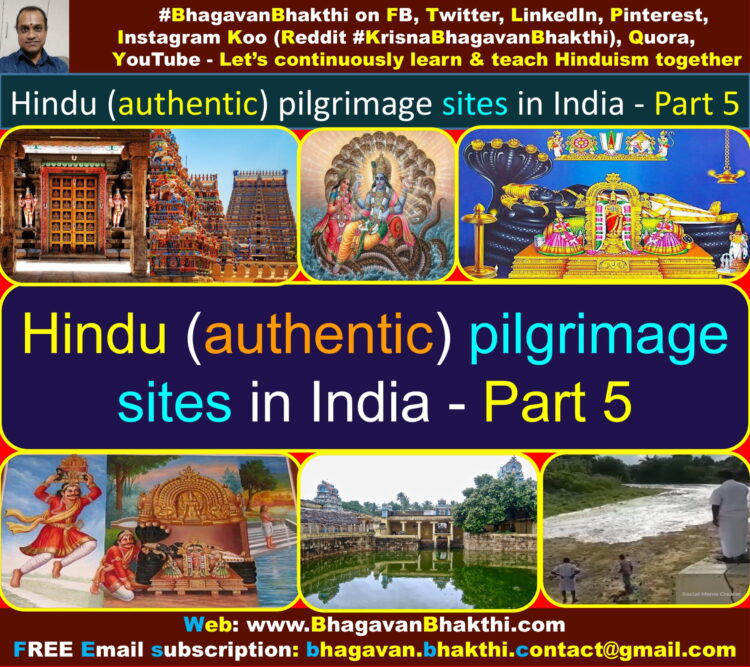
I urge to the readers to read this post completely and also to read the other posts connected with this post, to understand about all the pilgrimage sites of India with authenticity as per Hindu Puranas.
Note : Please note that, as said in the part 1, part 2, part 3 and part 4, this below information is based on an authentic grantha (Hindu text) which was written around 500 years ago.
And this is completely free from the today’s Babas, Swamy’s, modern temples, money oriented temples, etc. information.
For few web visitors, these pilgrimage places may look like unknown places.
But, all these places are genuine pilgrimages places as given in Hindu Puranas and other granthas (texts).
There was a great and divine saint (Sanyasi) in Udupi, in South India called as Guru Sri Vadiraja Tirtha nearly 500 years ago.
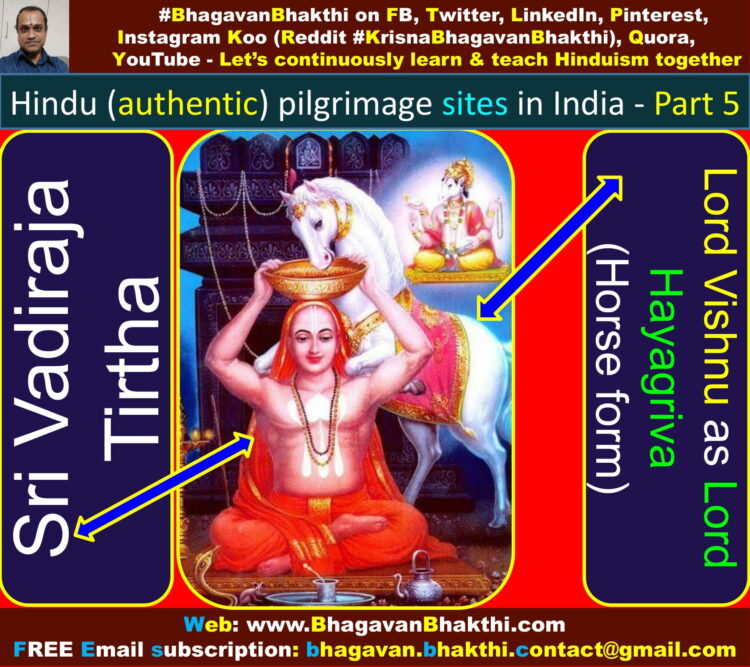
He had travelled all over India and had written a grantha (Hindu text) called as ‘Tirtha Prabandha‘ (pilgrimage places information).
In this grantha (Hindu text), he has given information about the various pilgrimage places around the India.
Guru Sri Vadiraja Tirtha visited the holy pilgrimage sites around India starting from Udupi (Karnataka) in a clockwise direction, through:
West —> North —> East —> Southern directions.
Finally Guru Sri Vadiraja Tirtha reached a place called today’s Thiruvananthapuram and submitted his holy grantha (Hindu text) at the lotus feet of Lord Sri Ananthapadmanabha Swamy in Kerala.
Now, let us know those pilgrimage places basic information.
Let us continue from “Hindu (authentic) pilgrimage sites in India – Part 1, Part 2, Part 3, Part 4“, that is, let us start from the Dhakshina (Southern) side from where we left in Part 4 as given below:
Dakshina Prabanda (India’s Southern side pilgrimage sites part 5 information) is as given below:
(This covers South-Western parts of the authentic pilgrimage places of India).
Srirangam Sri Ranganathaswamy (Sriranga Kshetra) : Srirangam (Sriranga Kshetra) is an island with a length of 27 km and breadth of 5 km.
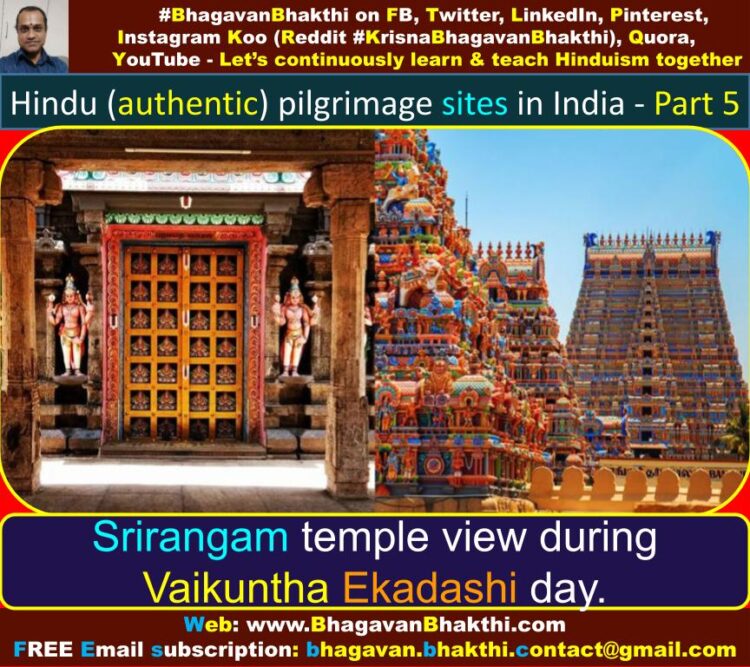
It is 10 kms away from today’s Tiruchirapalli (Trichy).
Lord Sri Ranganatha Swamy (Lord Vishnu) here is in the sleeping position on the five-hooded Lord Shesha Deva (Lord Aadi Shesha Deva).
The deities (murthy’s) of Goddess Sridevi, Goddess Bhoodevi and Vibhishana are at the feet of Lord Sri Ranganatha Swamy.
Sri Ranganatha (Lord Vishnu) was the ‘Kula Devata’ (Family God) of Lord Sri Rama.
After the requests by Vibhishana (Lanka’s Vibhishana), Lord Sri Rama handed over Sri Ranganatha Swamy to Vibhishana.
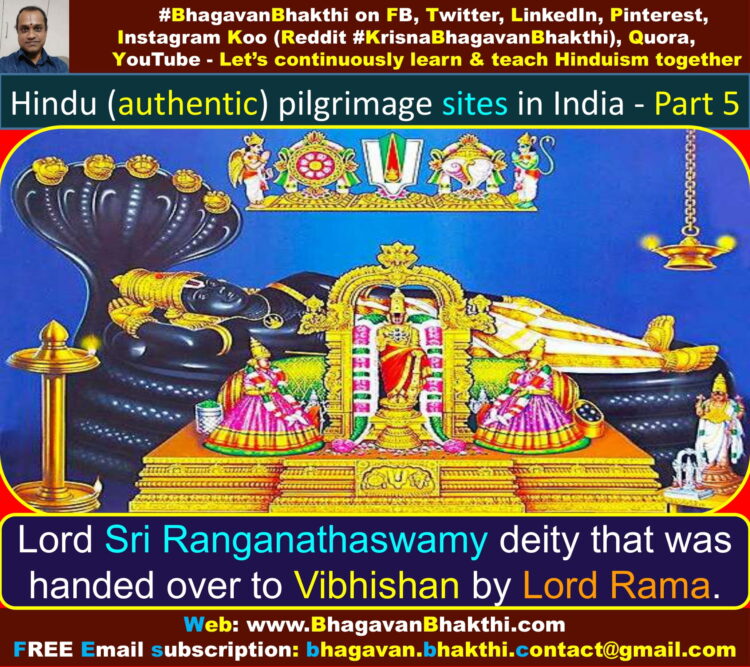
On his way towards Lanka (Today’s Sri Lanka), Vibhishana has to place the deity of Sri Ranganatha Swamy on the ground to perform ‘Sandhyavandanam‘.
Lord Sri Ranganatha Swamy remained there firmly (standstill).
But to bless Vibhishana and Lanka, Lord Sri Ranganatha Swamy is facing towards Lanka (Toda’s Sri Lanka).
Lord Sri Ranganatha Swamy is one of the eight ‘swayamvyakta mahakshetras‘ (self manifested great pilgrimage place) of India.
Please note that, in south India, there are three holy Lord Sri Ranganatha Swamy temples on the banks of river Kaveri.
These three temples of Lord Sri Ranganatha Swamy are known as ‘Aadi‘, ‘Madhya‘ and ‘Antya Ranga‘.
The first temple is at SriRangapatna near Mysuru, in Karnataka is called as ‘Aadi Ranga‘.
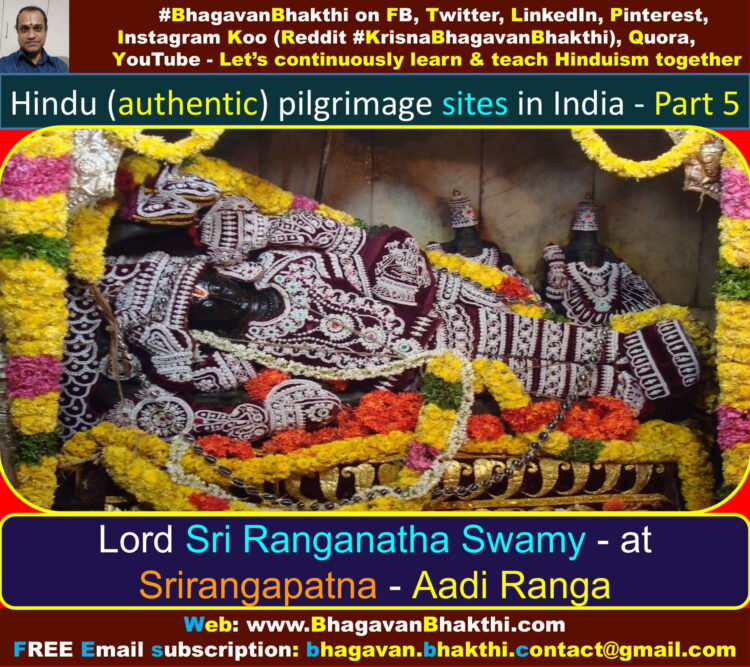
The second temple is at Shivanasamudra, again near Mysuru, in Karnataka is called as ‘Madhya Ranga‘.
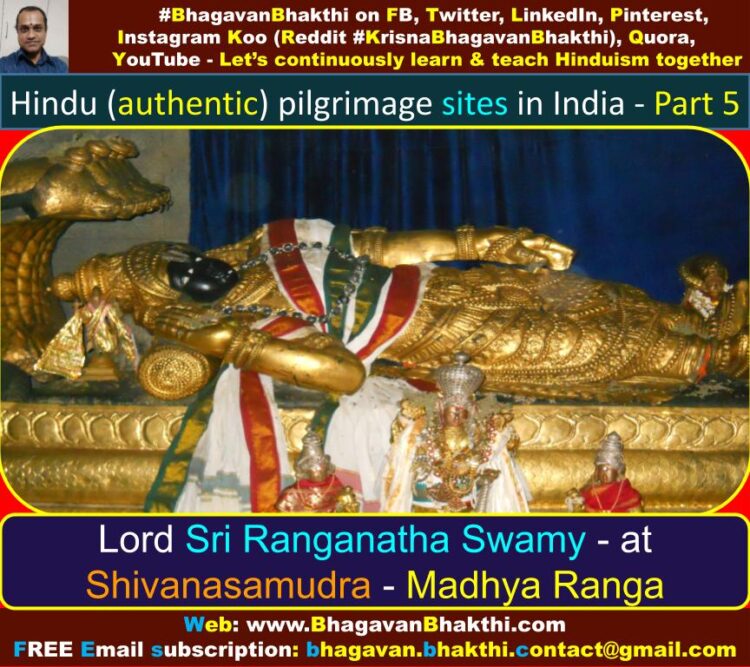
The third temple which is at today’s Srirangam in Tamil Nadu is called as ‘Antya Ranga‘.
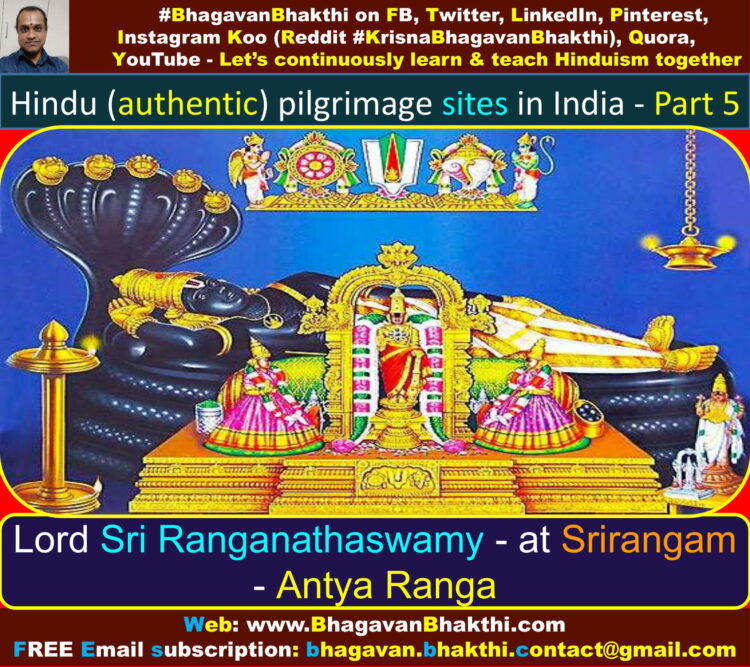
This temple at Srirangam in Tamilnadu (Trichy) has seven ‘prakaras’ and is the biggest temple in the world.
The outer most ‘prakara’ includes a significant portion of the town itself!
Important points about Srirangam’s Sri Ranganatha Swamy is as given below:
The Lord Sri Ranganatha Swamy’s deity (murthy) here was originally given by Lord Brahma Deva to the King Ikshvaku of the Suryavansh (Suryavamsha) (Solar Dynasty).
Even Bhagavan Lord Sri Rama worshipped this deity (murthy) as his ‘Kula Devata‘ (Family God).
Lord Sri Rama granted this to Vibhishana who, on his way to Lanka (Today’ Sri Lanka), stopped here for his ‘Sandhyavandanam‘ and placed it here.
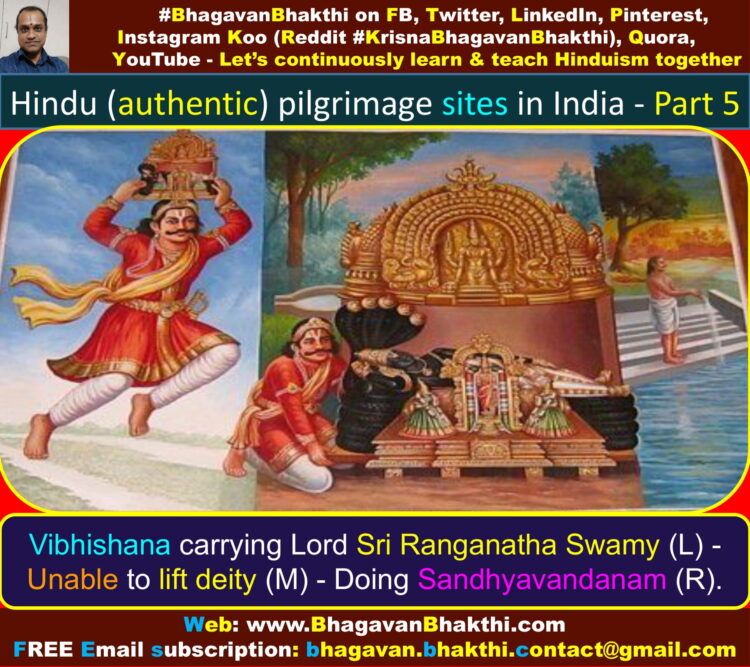
Due to the tapas of the Chola King called as ‘Dharmavarma‘, the deity (murthy) remained here without moving a bit.
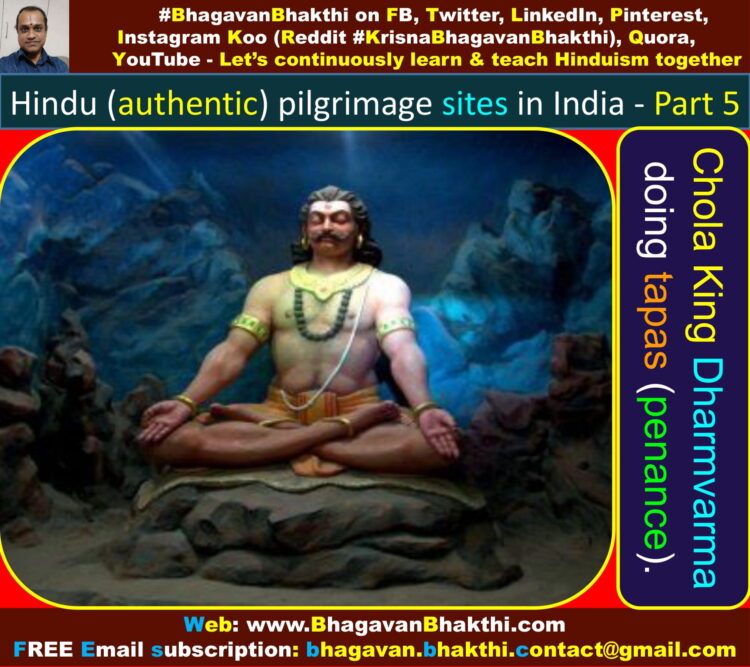
The divine and great saints (Sanyasis) of Dvaita tradition, that is, Sri Madhwacharya (Vayu avatar), Sri Jayatirtha (Indra avatar),
Sri Vyasa Tirtha (Prahlada avatar), Sri Sripadaraja Tirtha (Dhruva avatar), Sri Raghavendra Swamy (Another avatar of Prahlada) and Sri Vadiraja Tirtha (The future Lord Brahma Deva) have all visited this place.
And not only visited and stayed here for some time, but they stayed here for a considerable amount of time and also worshipped Lord Sri Ranganatha Swamy.
Few people question that, in Srirangam Lord Sri Ranganatha Swamy (Lord Vishnu) will always be sleeping, what is the divine story behind this?
Answer is like this : Sleep always indicates the of ‘tamo guna’ (Tamasika Guna) in humans.
Hence this Tamasika Guna is the reference to the removal of sleep and associated ailments like laziness, ignorance etc.
One must remember that Lord Sri Ranganatha Swamy (Lord Vishnu) never has any defect, even if he is forever appearing in the sleeping posture.
Lord Sri Ranganatha Swamy (Lord Vishnu) is called as ‘sarva-dosha-rahitam‘, that is, He is free from all the flaws, etc.
Here we should note that Lord Adi Shesha in his ‘moola roopa’ (Original form) possesses 1000 faces and 2000 tongues.
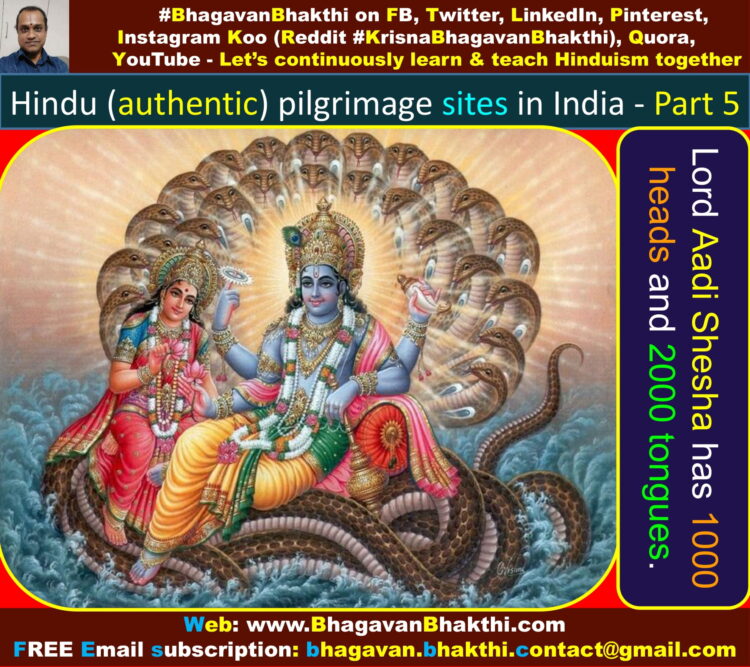
However, at Srirangam, Lord Adi Shesha has 5 faces and 2 tongues.
Thus this place Srirangam is also called as ‘Panchapani Kshetra‘ (Here Pancha = 5), as Lord Shesha spreads his five hoods as umbrella over the head of Lord Sri Ranganatha Swamy (Lord Vishnu).
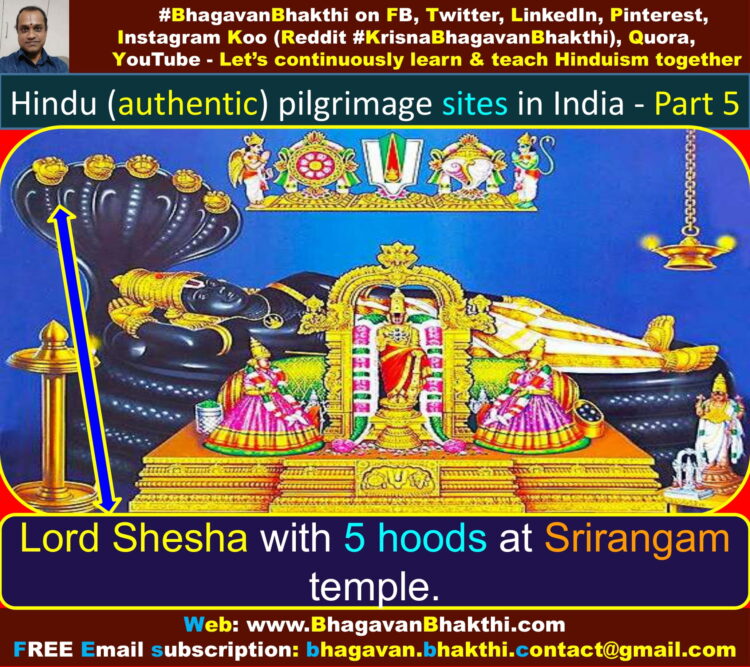
Chandra Pushkarini : In Srirangam temple, on the fifth ‘prakara’, there is a divine pond known as ‘Chandra Pushkarini‘ in the form of ‘full moon‘.
This divine Chandra Pushkarini, is the place where Lord Chandra (Moon God) performed tapas (penance),
after deserting Ganga Devi who resides on the hair locks of Lord Shiva, cannot be served by those who have less fortune.
Chandra Pushkarini is a divine tirtha (pilgrimage site) situated at the fifth ‘prakara’ at Srirangam.
It is the place where Lord Chandra (Moon God) performed tapas (penance).
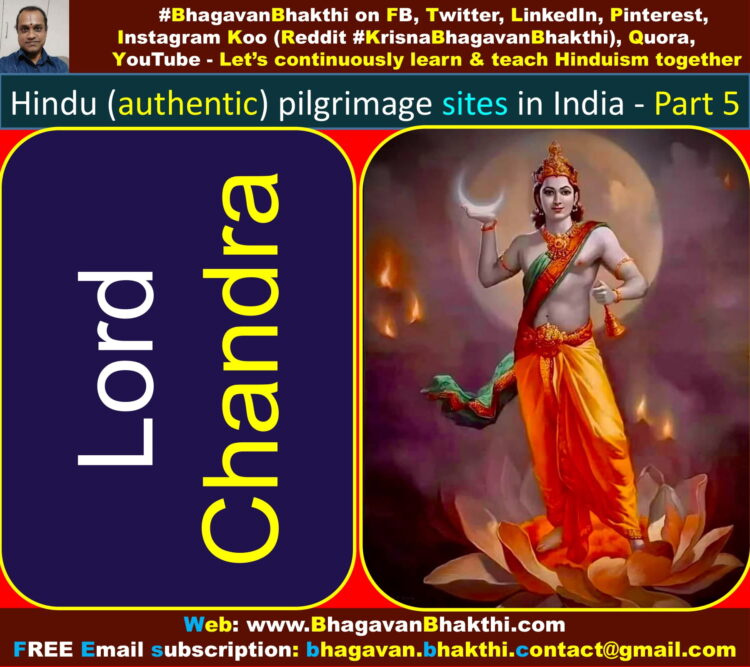
Since the ‘sannidhanam‘ (divine presence) of Lord Chandra (Moon God) is very high at this place –
Only an unfortunate one will choose not to worship Lord Chandra (Moon God) here.
That is what is highlighted by Guru Sri Vadiraja Tirtha during his visit to Srirangam.
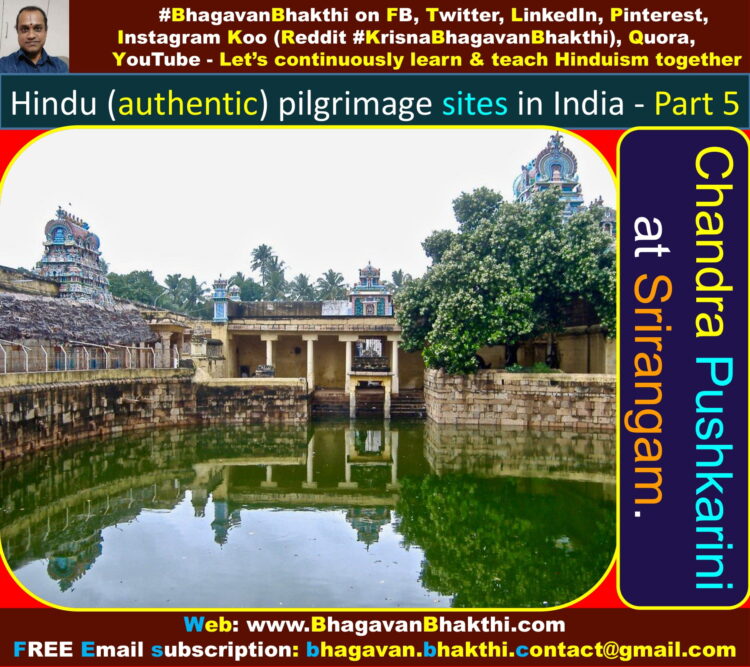
Kaveri (Cauvery) river : This river originates from Sahyachala (Tala Kaveri at Kodagu district of Karnataka) and merges with today’s Bay of Bengal beyond Thajavur of Tamil Nadu.
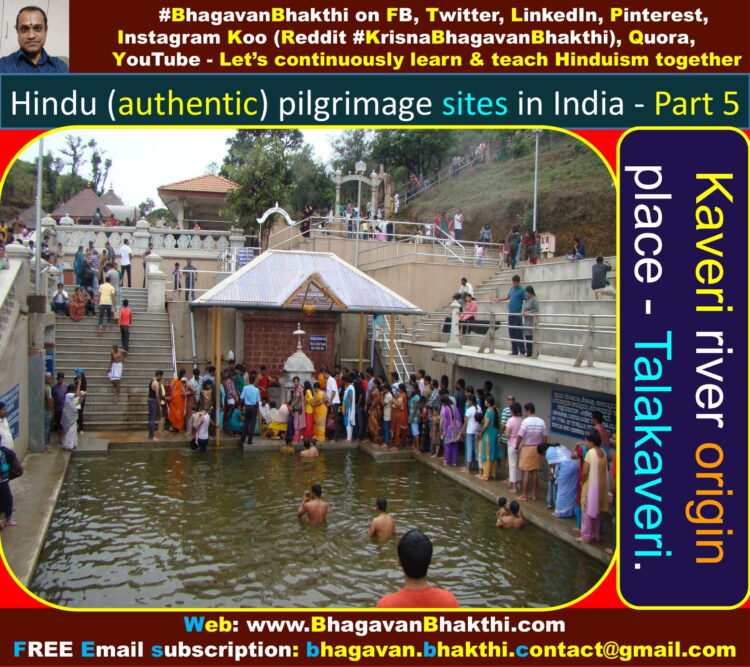
During Tula masam, Holy Ganga Devi will be present in Kaveri water.
The divine river Kaveri is one of the 7 Maha Nadis (Great and divine rivers) of India.
Kaveri river name is mentioned in the great and divine Vedas, Mahabharata, Srimad Bhagavatam and other major Puranas.
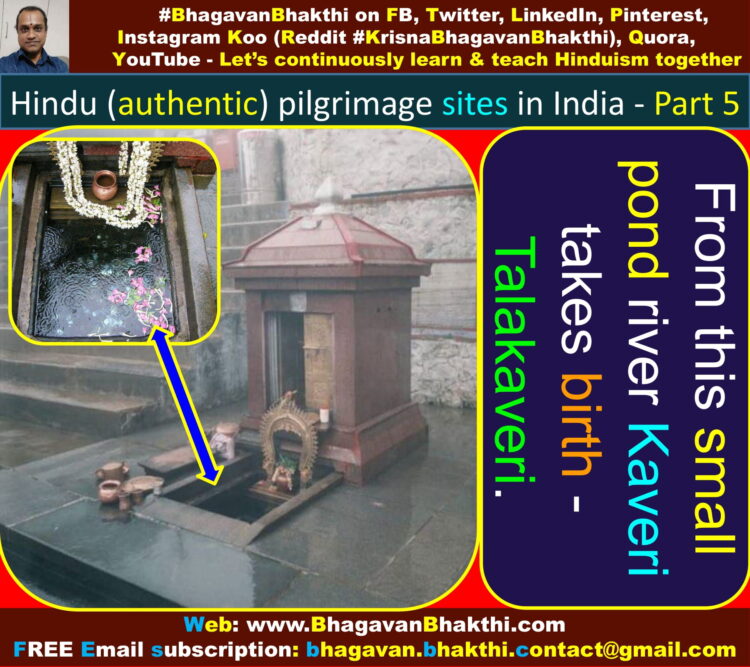
At all the three Sri Ranganatha Swamy Kshetras, that is, Aadi Ranga, Madhya Ranga and Antya Ranga, the temple of Lord Sri Ranganatha Swamy is on an island formed by the river Kaveri.
This divine river Kaveri splits into two channels and again rejoins.
Hence Guru Sri Vadiraja Tirtha explains that divine Kaveri Devi has the Lord (Sri Ranganatha Swamy) in her heart always. Hence this formation.
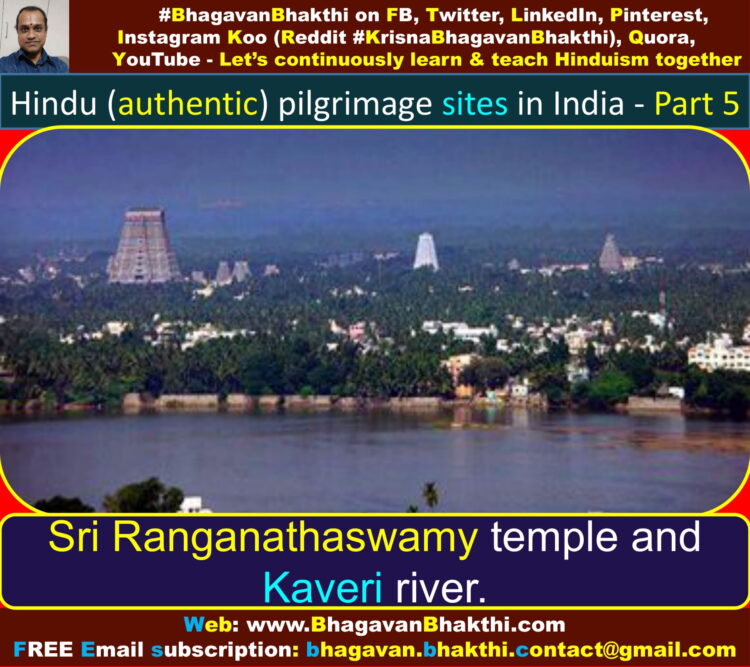
We should note that, it is true that Indian divine rivers are capable of granting mukti (moksha) (A place in Vaikuntha) are found in many places.
However, this divine river Kaveri, the mother of the people of Cholas, is the giver of both Bhakti (devotion) and mukti (moksha) both.
It is a well known fact that the divine river Kaveri provides water for irrigation throughout her journey (from origin point until she get merged with Ocean).
Lakhs and crores of farmers depend upon this divine river Kaveri for her blessings.
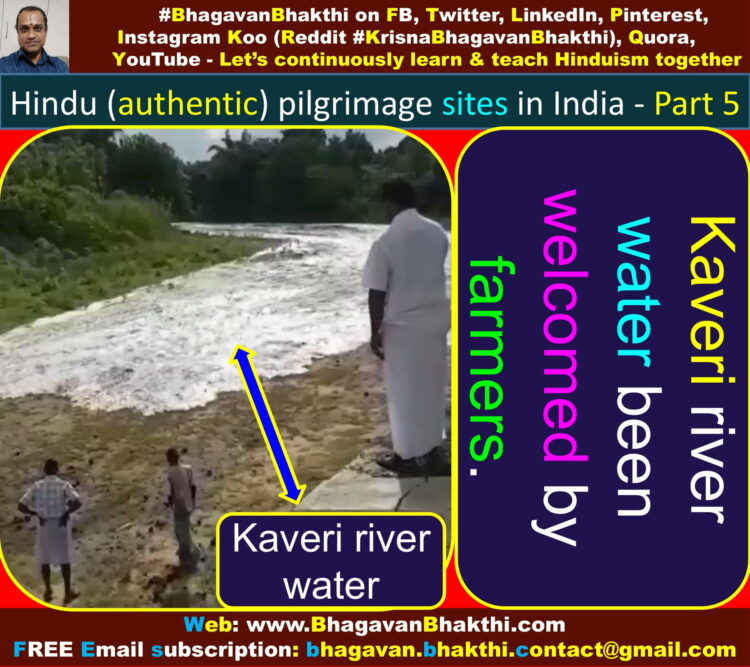
The same is highlighted by Guru Sri Vadiraja Tirtha when he visits this pilgrimage site.
Alagar (Azhagar) Kovil (Vrishabhachalam) : This holy place is located around 20 kms from today’s Madurai.
Alagar (Azhagar) Kovil was called as Vrishabhachala ( Vrishabhachalam) (वृषभचलं / ವೃಷಭಾಚಲಂ / vr̥ṣabhācalaṁ) (Lord Vishnu temple).
Once Lord Yama Deva did deep tapas (penance) in the full to earn the grace of Lord Vishnu.
Lord Vishnu appeared in this place as ‘Sundara Raja‘ (The most beautiful Supreme Personality) before Lord Yama and blessed him in this place.
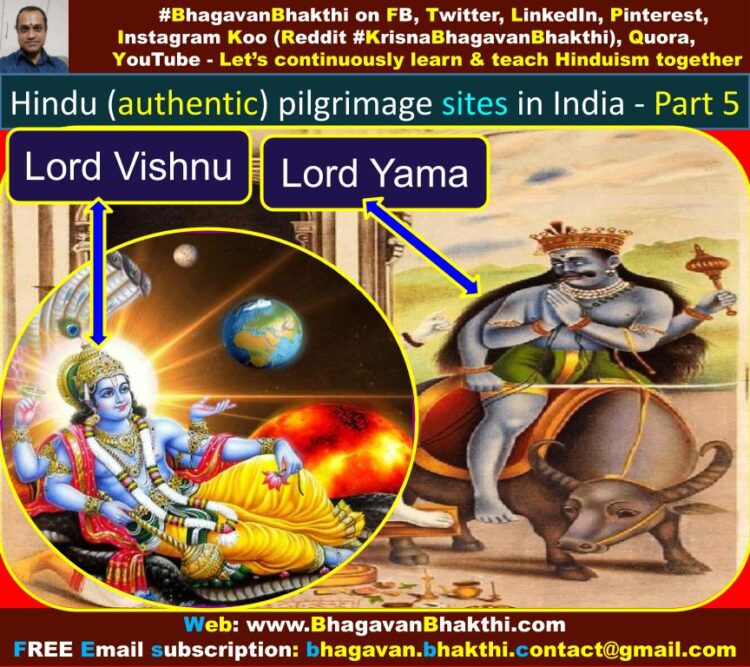
Noopura Ganga (Gangai) : When Lord Vishnu appeared as Lord ‘Sundara Raja‘ before Lord Yama,
the holiest river Sri Ganga Devi emerged out of his anklets and formed Nupur (Noopura) Ganga in this place.
In Sanskrit anklets means Noopura (Nupur) (नूपुर / ನೂಪುರ / nūpura).
Since anklets (Noopura) (Nupur) are decorative ornaments, Guru Sri Vadiraja Tirtha prays for the river to wash away all the sins in our heart.
And thus then decorate it in our heart, thereby also rendering it pure.
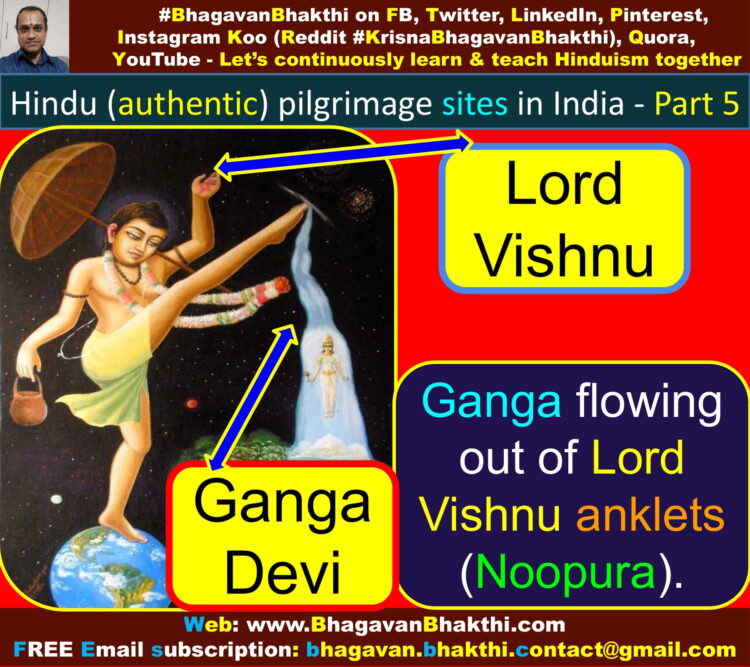
Darbhasayanam (Adi Jagannatha Perumal Temple) : This revered temple is located in Thirupullani around 10 kms away from Ramanathapuram town in Tamil Nadu.
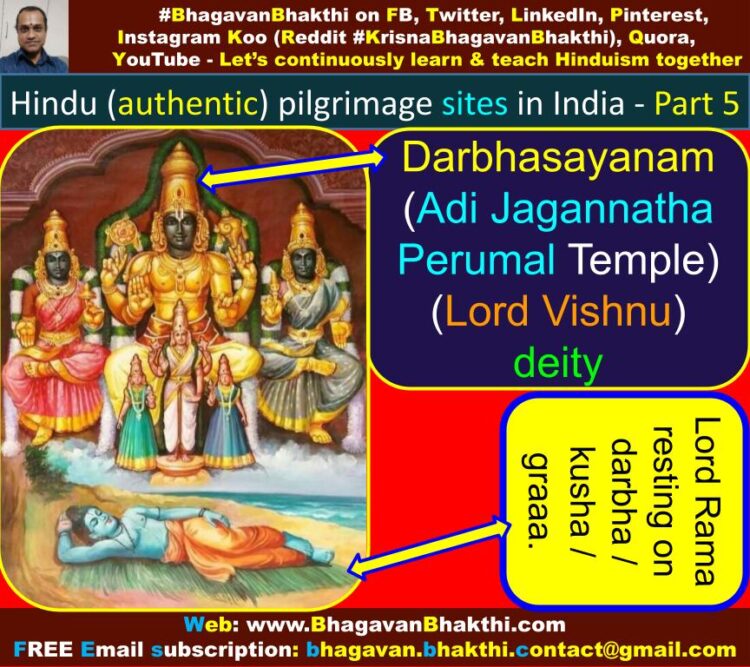
In Sanskrit, this place is called as ‘Darbhashayanam’ (दर्भशयनं / ದರ್ಭಶಯನಂ / darbhaśayanaṁ).
According to legends, Lord Rama slept over darbha (grass) here for three days.
He does like this, to please Lord Varuna (Sea God) for constructing a Rama Setu (Rama bridge) over it, to cross the ocean and reach Lanka (Today’s Sri Lanka) in search of Goddess Sita Devi.
When Lord Rama was at Chitrakoot along with Goddess Sri Sita Devi and brother Lakshmana, an asura (demon) named Kuranga had attempted to touch Goddess Sri Sita Devi.
Lord Rama then had used a blade of darbha (grass) and turned it into an astra (weapon) and killed that demon.
In order to bless the darbha (grass) for being useful in that incident,
Lord Sri Rama chose to sleep on the same Kusha (darbha) (Another name of grass in Sanskrit),
when Lord Rama was waiting for Lord Varuna (Ocean God) to make way to Lanka (Today’s Sri Lanka).
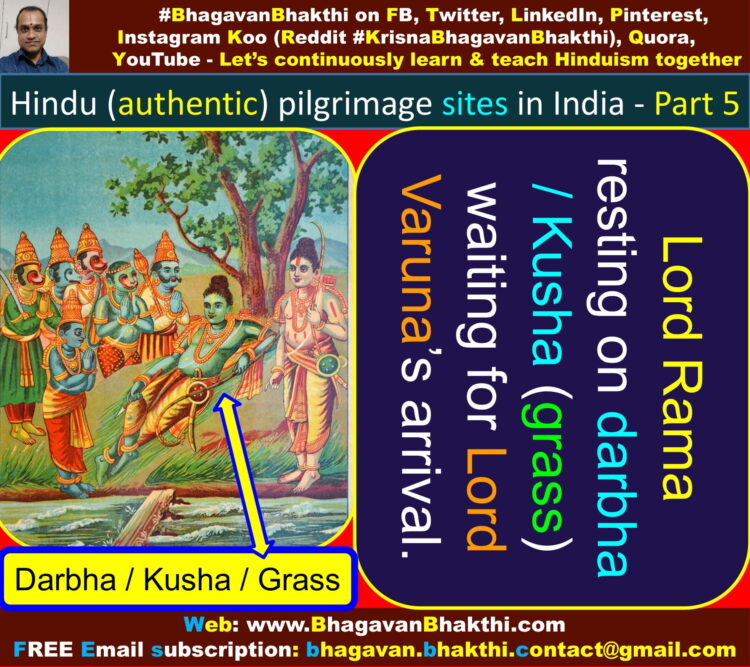
Guru Sri Vadiraja Tirtha when visited this place, praises the ‘darbhasayanam‘ place in Ramanathapuram, in Tamil Nadu.
It is at this place that Lord Rama waited for Lord Varuna (Ocean God) to allow cross the ocean to reach Lanka (Today’s Sri Lanka).
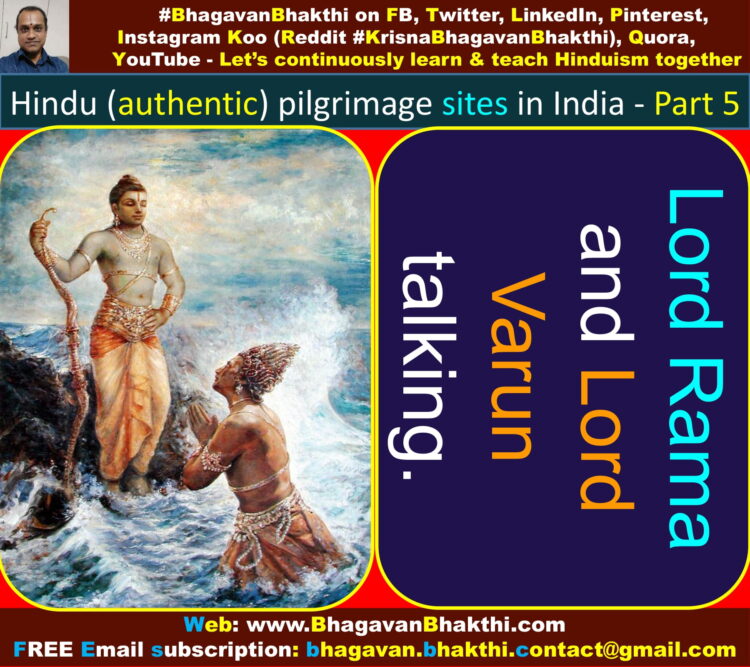
It is at this place Vibhishana came over and joined the side of Lord Rama.
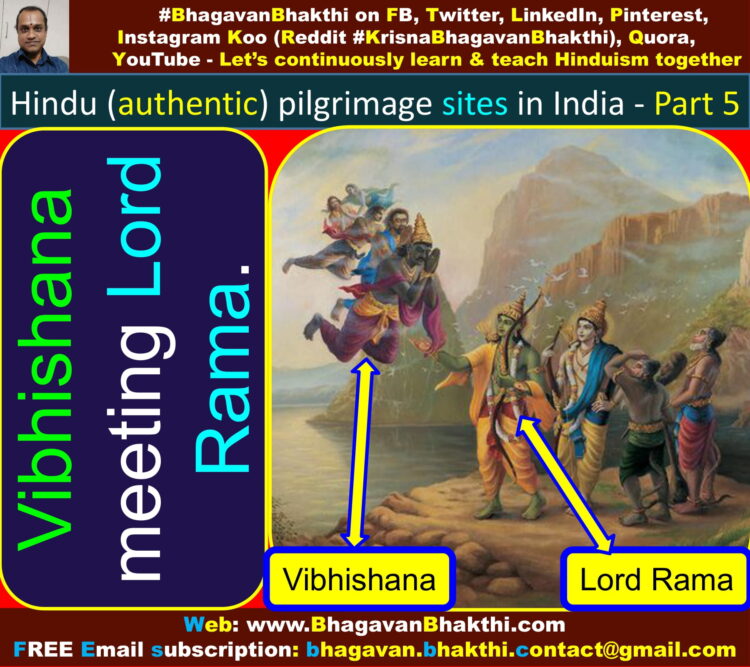
At this temple, a two-armed deity (murthy) of Lord Rama can be found.
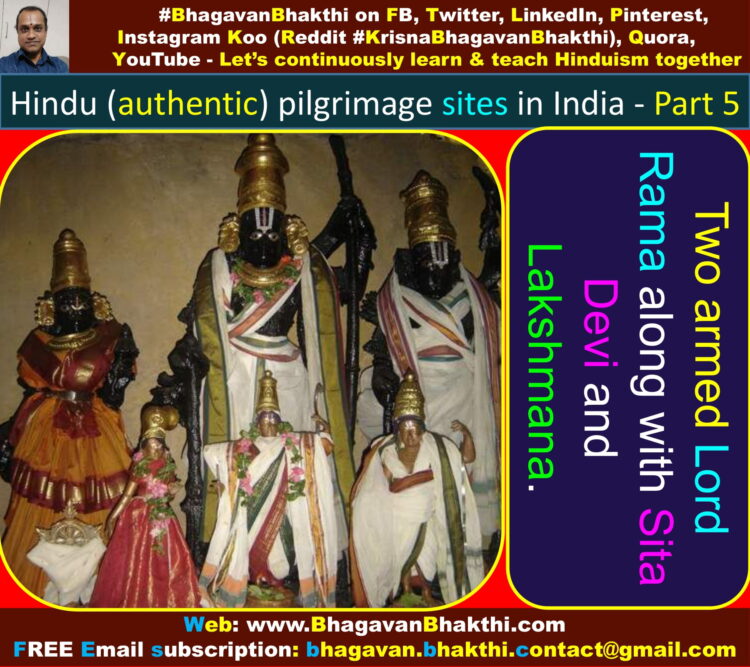
Rama Setu (Rama’s bridge) (Adam’s Bridge) : This man made bridge is of 100 yojana in length.
It was built by Lord Rama near Rameshwaram (Rameswaram) at Dhanushkodi (Dhanushkoti).
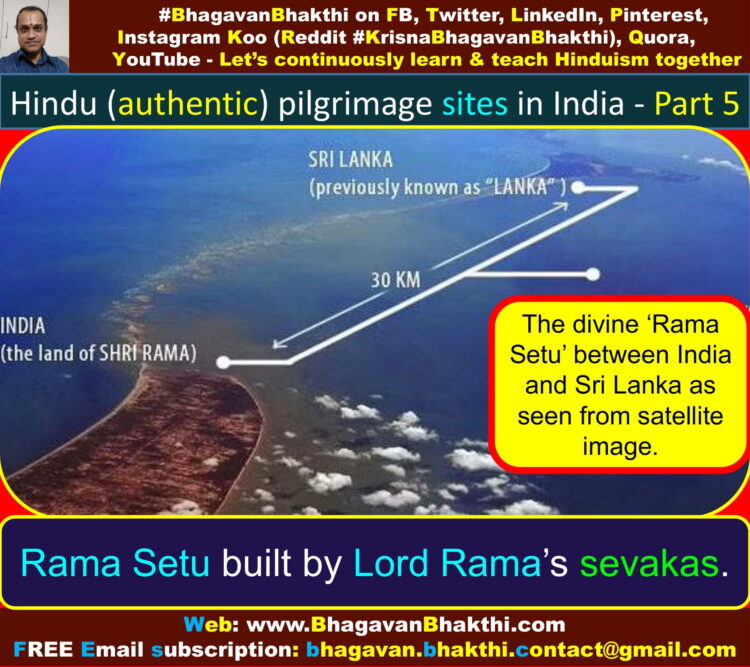
Guru Sri Vadiraja Tirtha adds the narration that, how Lord Hanuman was helpful in constructing the bridge (Setu).
Guru Sri Vadiraja Tirtha compares this bridge (Setu) to Bhudevi (Mother Earth).
Since Goddess Sri Sita Devi emerged from the soil (Thus the name Sita), Bhudevi is like her (Sita’s) mother.
Hence Lord Rama is like the son-in-law of Bhudevi (Mother Earth).
In another analogy, the bridge (Setu) is compared to the huge mountains.
In the Hindu Puranas it is mentioned that huge mountains support Bhudevi (Mother Earth) to reduce her burden.
Hence the comparison is very apt here with the Rama Setu.
The right quality and value of gold is determined by a goldsmith, by using a touchstone.
Similarly, the bridge at ‘Rama Setu’ stands an example of the valour of Lord Rama for ordinary people who sing his greatness.
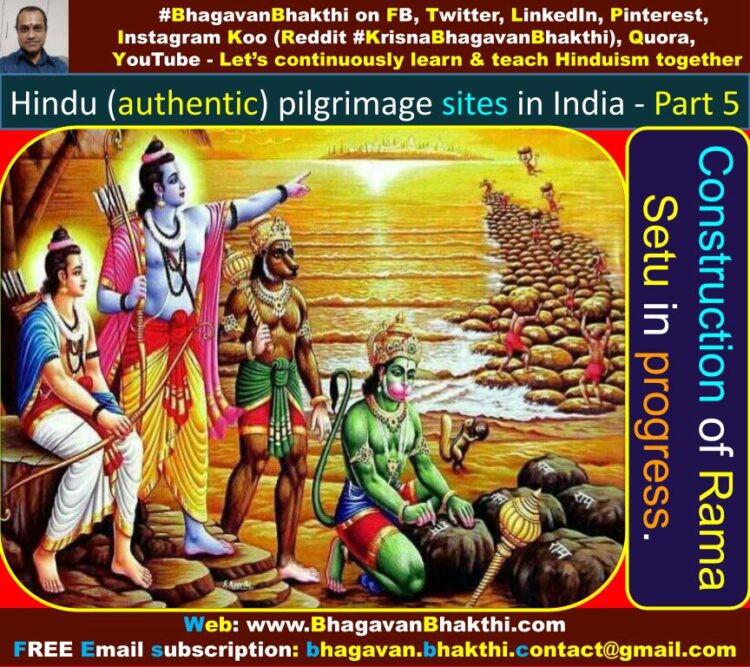
During the construction of the Rama Setu, Lord Hanuman plucked numerous mountains and covered the ocean with the same.
Thus speeding up the construction work.
Many earlier poets have claimed that wind (Vayu) cannot match mountains.
Guru Sri Vadiraja Tirtha refutes the same here, by showing how the son of Lord Vayu Deva uprooted many mountains during the process of building the bridge.
Guru Sri Vadiraja Tirtha adds that, throughout the Rama Setu, the waves of the ocean kept on rising.
Guru Sri Vadiraja Tirtha narrates this as a show of devotion by Lord Varuna (Ocean God), since Lord Rama had walked over each of those stones.
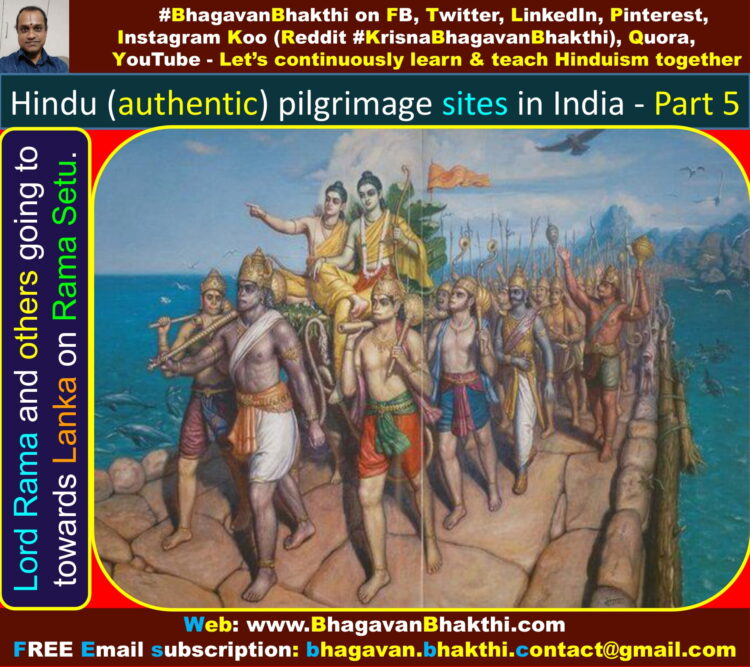
Thus leaving behind a little bit of the dust from his feet, over which Lord Varuna (Ocean God) is showing extreme devotion with attachment.
Rameshwaram (Rameswaram) : In older days, this place was also called as ‘Gandha Madana’ (गन्धमादन / ಗಂಧಮಾದನ / gandhamādana).
Guru Sri Vadiraja Tirtha explains the ‘prathistapanam’ (installation) of Linga by Lord Rama.
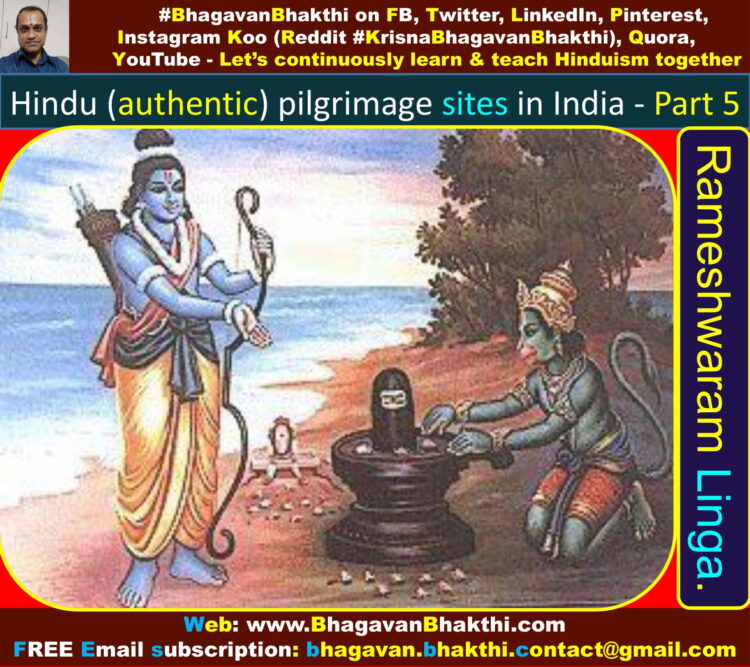
Rameshwaram is one of the most holiest kshetras (pilgrimage place) in southern India.
This place is also known as ‘Devanagara’ (देवनगर / ದೇವನಗರ / dēvanagara) in earlier days..
The great epic Mahabharata records the visit of Pandavas and Balarama to Rameshwaram.
The great and divine Guru Sri Madhwacharya had also been to this place and performed one of his chaturmasa here.
Along with Dwarka (west), Badrinath (north) and Puri (east), Rameshwaram (south) is considered among four of the greatest ‘Tirtha Kshetras‘ (pilgrimage place) in India.
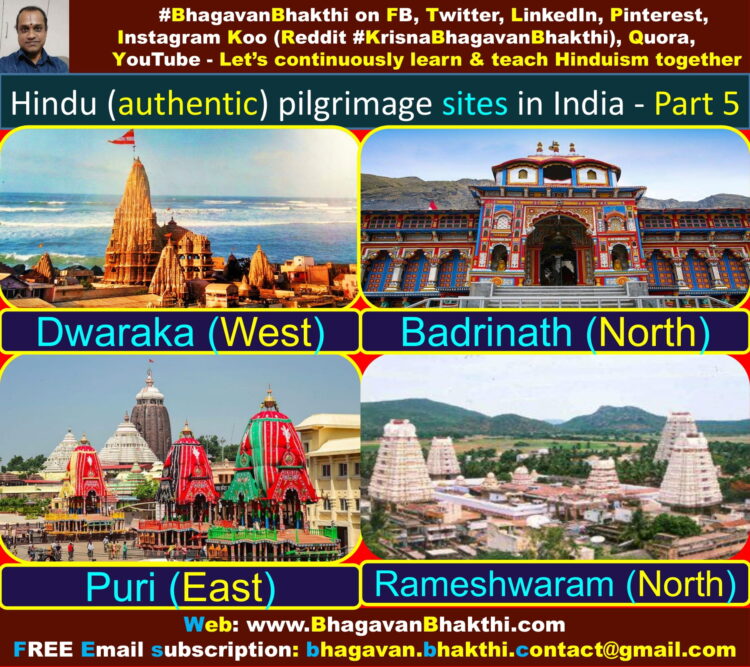
Guru Sri Vadiraja Tirtha during his visit to Rameshwaram, clarifies that –
the establishment of the Lord Shiva’s Linga at Rameshwaram by Lord Rama was not with the purpose of worshipping him (Not worshipped by Lord Rama).
And also nor because Lord Shiva is the Supreme God.
Also, he adds that it was not at all to destroy the sins of ‘brahma hatya‘ (killing a Brahmana, that is, Ravana).
Lord Rama (Lord Vishnu) destroys all during the final pralaya.
Thus, there is no need for Lord Rama (Lord Vishnu) to depend upon another ‘samharakarta’ (संहारकर्त / ಸಂಹಾರಕರ್ತ / sanhārakarta).
But Lord Rama establishes Lord Shiva Linga for the purpose of ‘Loka Shikshana’ (लोक शिक्षण / ಲೋಕ ಶಿಕ್ಷಣ / lōka śikṣaṇa).
That is, to teach the common man how to worship Lord Shiva and other Devatas (Demigods).
Guru Sri Vadiraja Tirtha also adds that, The name of ‘Sri Rama‘ mantra of Lord Rama relieves one from all sins.
This most divine mantra of ‘Sri Rama‘ is therefore known as ‘taraka mantra‘.
Lord Shiva is in continuous and constant meditation of Lord Rama ‘Sri Rama‘ mantra.
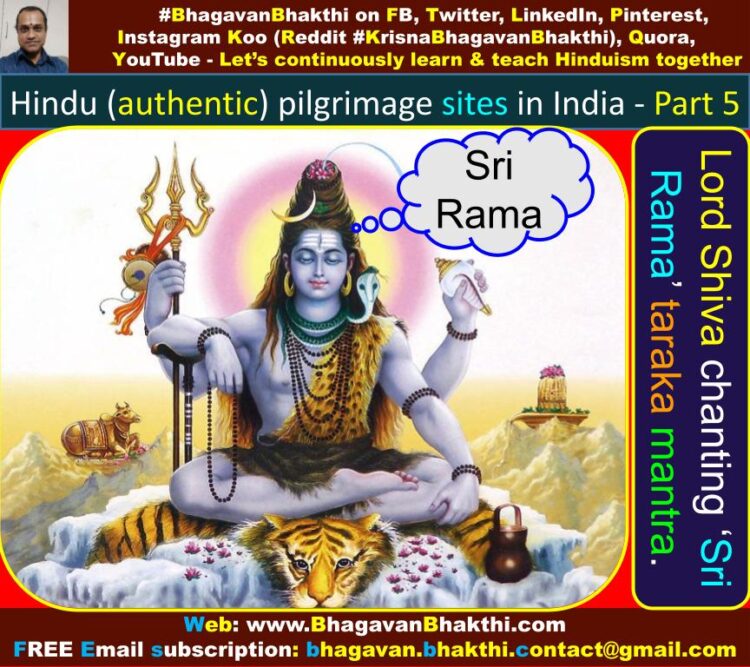
Thus being the case, there is no possibility of Lord Rama depending upon Lord Shiva to rid himself of his supposed sins.
This is the essence of the question embedded by Guru Sri Vadiraja Tirtha.
Guru Sri Vadiraja Tirtha adds one more point during his visit to Rameshwaram as given below:
Guru Sri Vadiraja Tirtha, once again, questions the story of Lord Rama trying to get rid of his ‘brahma hatya dosha’ (Blot of killing a Brahmin).
When Lord Shiva himself was afflicted with ‘brahma hatya dosha‘, when he cut off the fifth head of Lord Brahma, how can he rid Lord Rama from that very kind of sin?
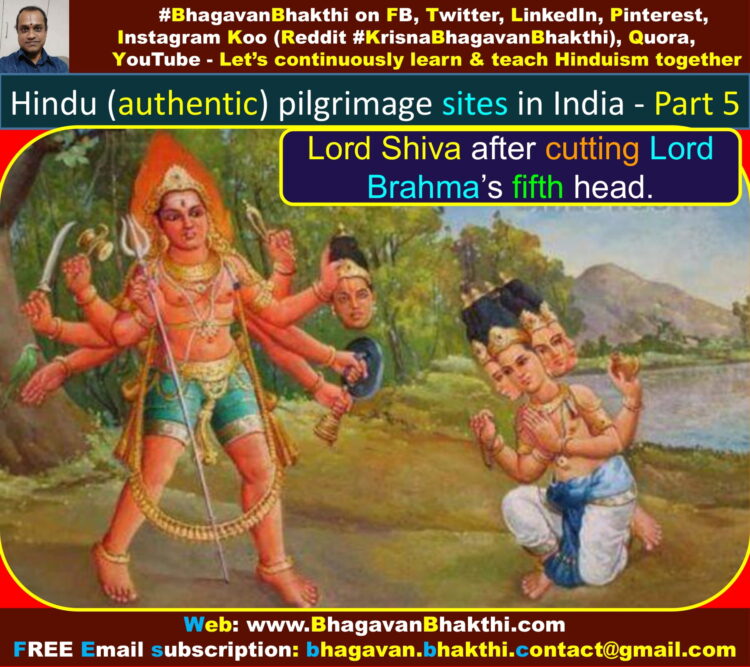
यद्रावणवधे हेतुः सेतुर्जेतुं क्षमस्तमः | तदघं तद्रिपोरासीदसङ्गस्य किलाद्भुतम् ||
Meaning of the above shloka by Guru Sri Vadiraja Tirtha : In this shloka, Guru Sri Vadiraja Tirtha mocks at those who say that Lord Rama was afflicted by ‘brahma hatya dosha‘.
The mere sight of the Rama Setu relieves one from ‘brahma hatya dosha‘.
This is because, it played a small role in aiding Lord Rama during his killing of the demon King Ravana.
This being the case, claiming that the one who actually killed Ravana was afflicted by ‘brahma hatya dosha‘ is ridiculous!
When the bridge which became an instrument in the killing of the demon King Ravana itself is capable of relieving the ‘sin of brahma hatya‘,
it seems that same sin afflicted his Ravana’s enemy, the one who is untouched by anything. What a surprise!
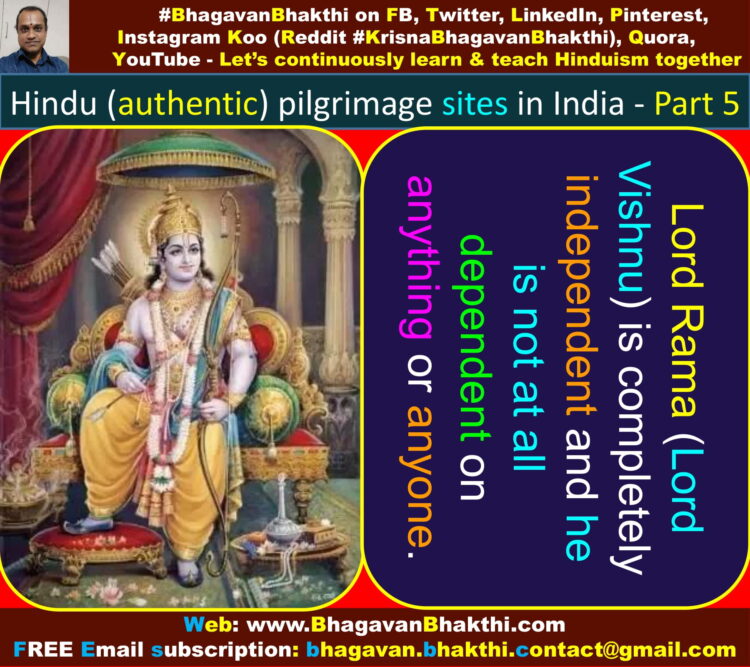
[We should always remember that, Sri Rama (Lord Vishnu) is not at all dependent on others.]
[He is completely independent and free to do anything and everything in this unlimited Universes as per his own wishes].
Dhanushkodi (Dhanushkoti) : This auspicious place around is 20 kms away from Rameshwaram.
The ‘Skanda Purana’ narrates that Vibhishana requested Lord Rama that –
he (Vibhishana) was afraid that, powerful kings may attack his kingdom by using the Rama Setu to cross over.
To offer him (Vibhishana) confidence, Lord Rama reversed his bow and broke a portion of the bridge over here in this place called Dhanushkodi (Dhanushkoti).
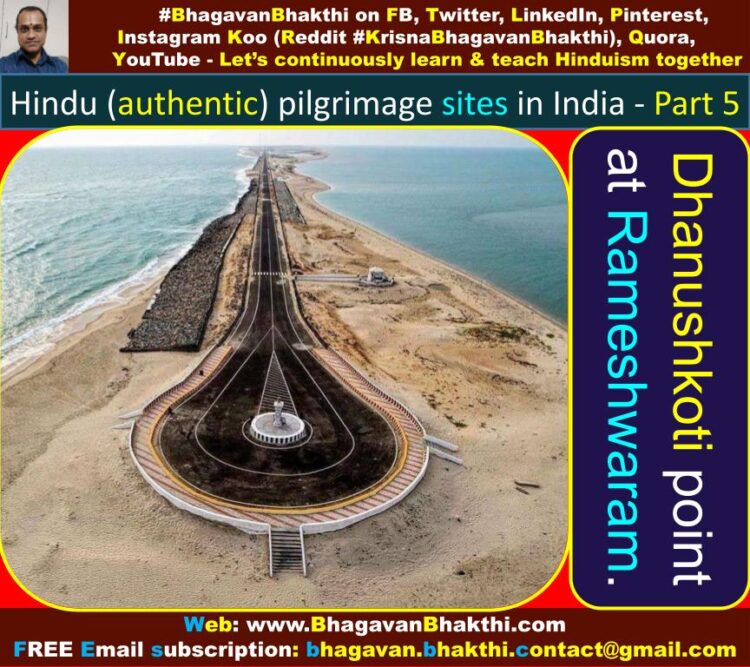
Guru Sri Vadiraja Tirtha says that, “O people! You are unnecessarily getting into a deplorable state by engaging in many danas (donations), adhyayana (studying), yagnas,
creation of ponds and other forms of implementation, when there is a big magic box called Dhanushkoti (Dhanushkodi) holding higher good deeds as wealth in it,
and which is capable of full-filling all desires of the clan of Devatas (Demigods) and the noble humans.
We should note that, Guru Sri Vadiraja Tirtha is not downplaying the importance of various Dharmic activities as per above sentence.
But, it is only to show the amount of good deeds that can be obtained by visiting this divine place at Dhanushkoti (Dhanushkodi).
This Kshetra (pilgrimage place) is so holy that, even the desires of Devatas (Demigods) are fulfilled by visiting this place.
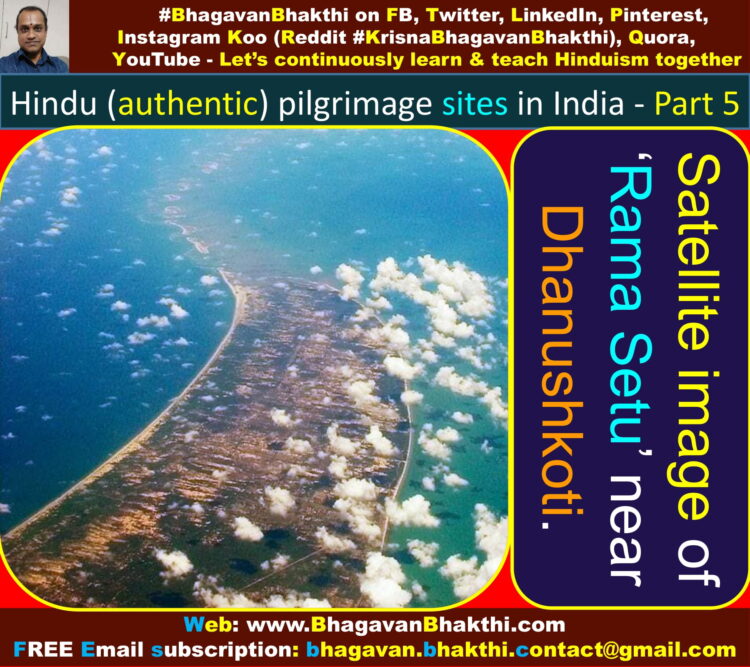
Tamraparani (Thamirabarani) (Tamraparni) (Porunai) river : Guru Sri Vadiraja Tirthat says that –
those who are desirous of moksha (A place in Vaikuntha) should definitely need to drink the water from this river of Tamraparni.
This is because even a shell that is present in that river provides moksha (A place in Vaikuntha) to the water that’s fallen inside it.
Here we should note that, Tamraparni (Thamirabarani) river flows near Tirunelveli in Tamil Nadu.
This sacred river is mentioned in several Puranas including the Srimad Bhagavatam and Kurma Purana.
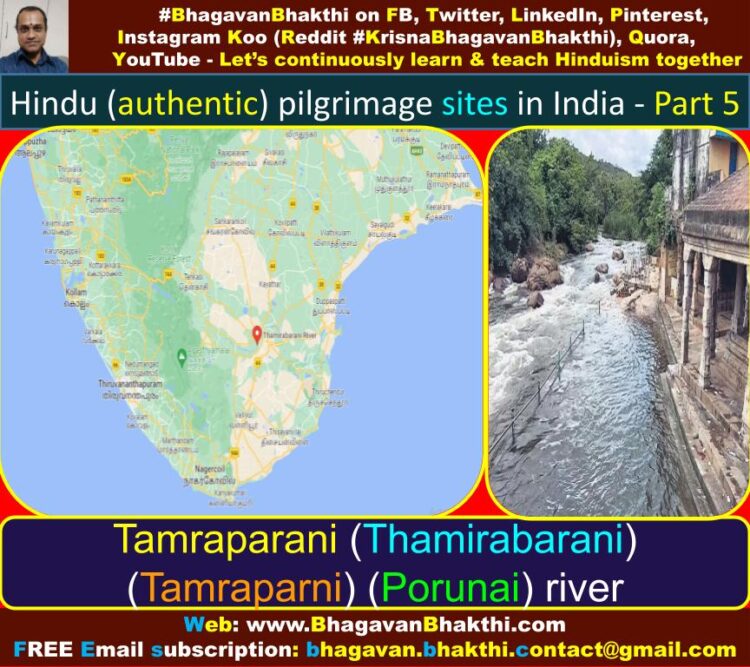
The Srimad Bhagavatam mentions that consuming the water of this river increases bhakti (devotion) in Lord Vishnu.
The Tamraparani or Thamirabarani or Tamraparni or Porunai is a eternal river and, it
originates from the ‘Malayachala’ (‘Agastyarkoodam’) (Agasthyamalai) peak of Pothigai hills of the Western Ghats, above Papanasam in the Ambasamudram taluk of Tamil Nadu.
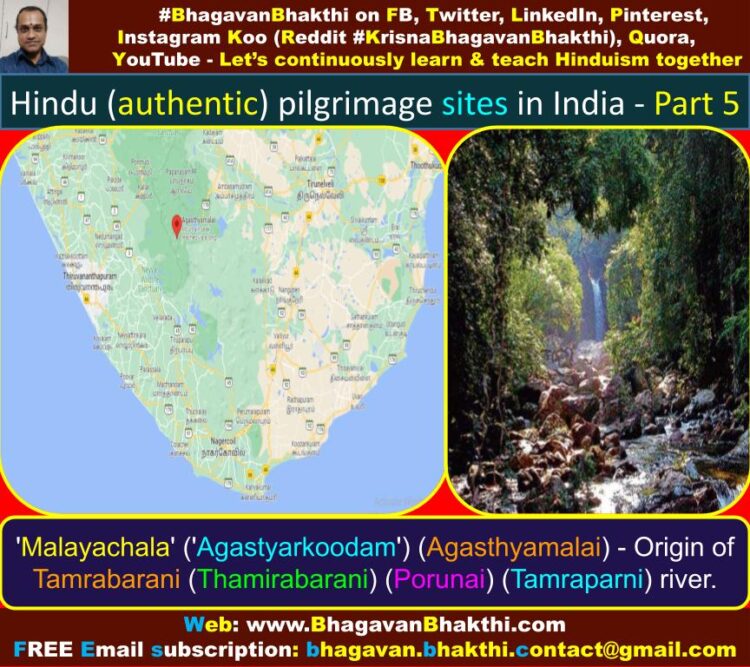
It flows through Tirunelveli and Thoothukudi districts of the Tamil Nadu state of southern India into the Gulf of Mannar.
It was called the Tamraparani (Tamraparni) river in the Puranic period.
This name Tamraparani (Tamraparni) is a name it lent to the island of Lanka (Today’s Sri Lanka).
The old Tamil name of the river is Porunai.
From the source to sea, the river is about 128 km long and is the only perennial river in Tamil Nadu.
This river flows towards north direction initially, but however, later it changes it’s direction towards east.
Guru Sri Vadiraja narrates that, this river as the power of converting rain water into pearls.
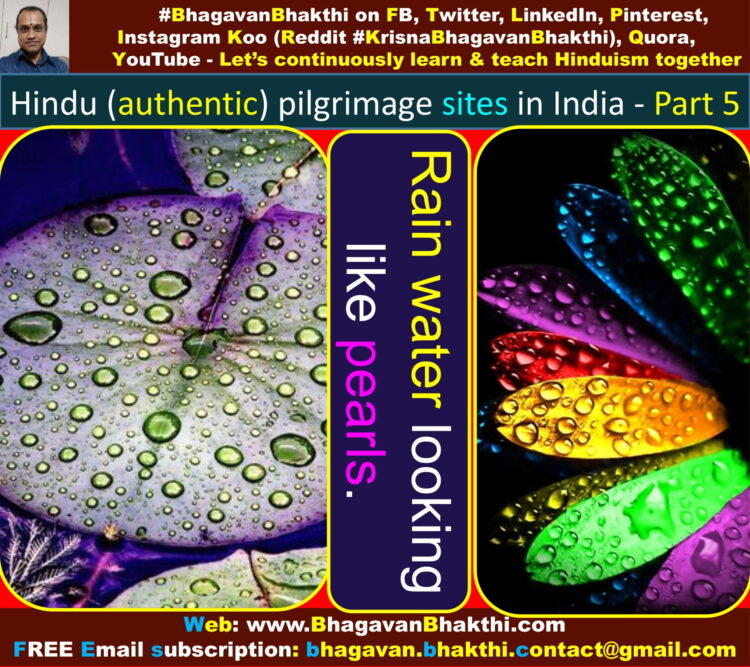
Mahendragiri (Mahendra hills) (Tamil Nadu) : It is existing near Darbhasayanam at Ramanathapuram in Tamil Nadu.
Lord Hanuman while on his search to locate Goddess Sri Sita Devi, puts his leg forward to take a step on this mountain.
Because of this, the whole mountain was pressed down to the bottom of the sea due to Lord Hanuman’s force.
Mahendragiri (Mahendra Hill) was the hill on which Lord Hanuman stood before launching himself into the sky to reach Lanka (Today’s Sri Lanka) to search Goddess Sita Devi.
Due to the force applied by him on the hill, most of the hill sunk into the earth.
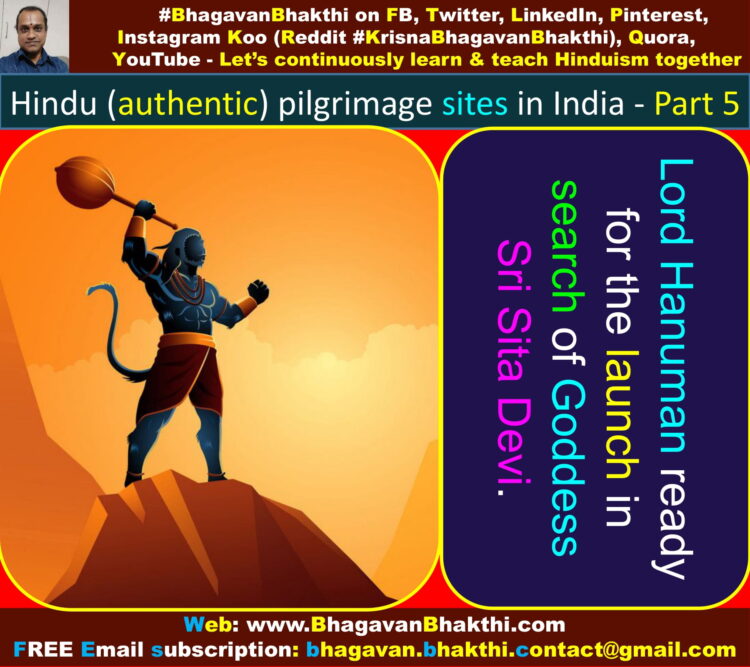
Guru Sri Vadiraja Tirtha explains the incident very beautifully by saying that, the mountain went inside of the earth to convey a message to Bhudevi (Mother Earth) about her daughter Goddess Sri Sita Devi.
Kanyakumari (Arulmigu Bhagavathy Ammam Alayam) : This divine place is 96 kms from Tirunelveli.
We can very easily see a Sangam (Sangamam) of Arabian sea, Bay of Bengal and Indian ocean in this very place.
Guru Sri Vadiraja Tirtha worships the divine power of Sridevi (Goddess Sri Maha Lakshmi Devi) (Sri Satyabhama Devi) in the form of Kanyakumari.
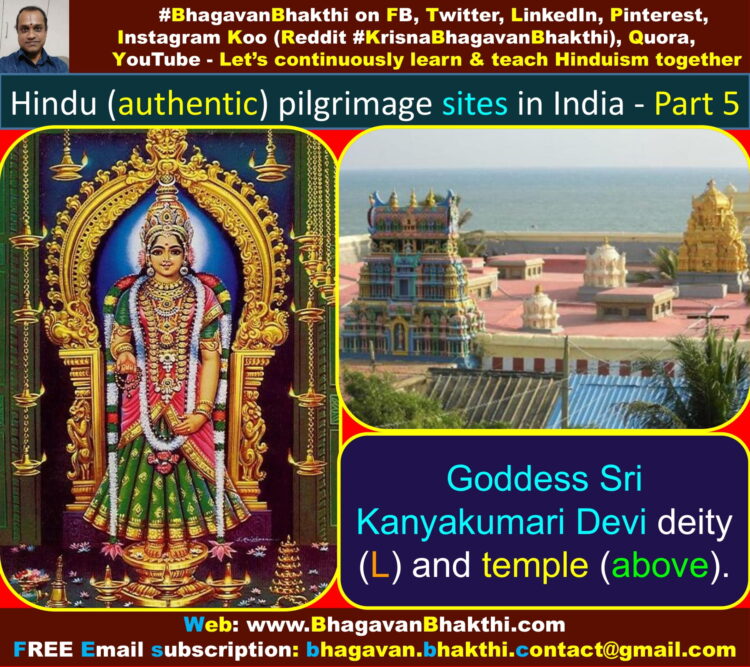
Guru Sri Vadiraja Tirtha narrates how Goddess Kanyakumari defeated Banasura.
Guru Sri Vadiraja explains Sri Kanyakumari as Goddess Sri Maha Lakshmi Devi.
Guru Sri Vadiraja in his grantha ‘Tirtha Prabandha‘ says that:
या सूते सेवमानानां भाग्यारोग्यापुनर्भवान् | कन्या किलेयं तीर्थं च कन्यातीर्थमिदं किल ||
Meaning of the above shloka : She is someone who delivers wealth, health and moksha to those who worship her, is supposedly be a ‘Kanya‘, and this tirtha (pilgrimage place) is supposed to be a ‘Kanya Tirtha‘!
Guru Sri Vadiraja Tirtha eulogizes Goddess Sri Maha Lakshmi Devi at Kanyakumari with a slight tinge of sarcasm.
We all know that, Kanyakumari grants wealth and health to her devotees.
And also it is well known that, a snana (bath) at ‘Kanya Tirtha‘ grants moksha.
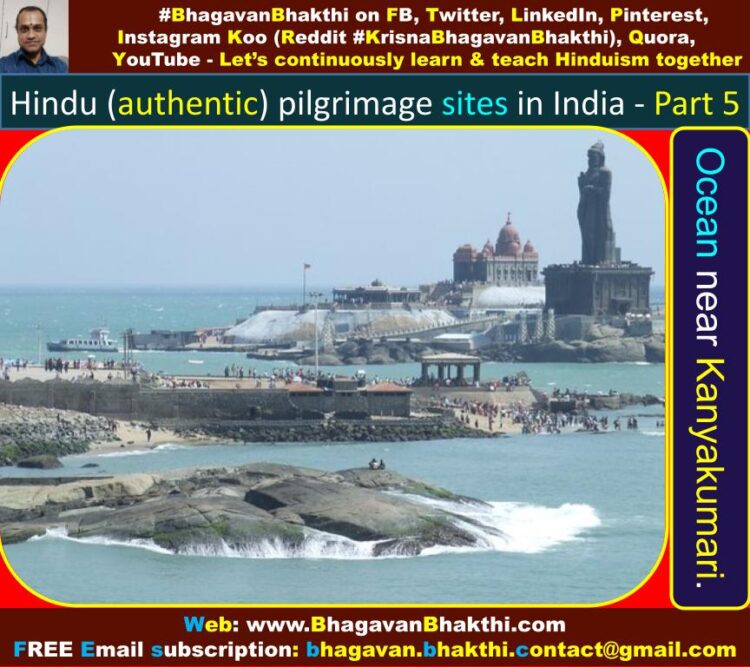
Guru Sri Vadiraja Tirtha uses the word “deliver” here, just to drive home the point that the ‘Devi‘ here is a ‘Kannika‘ and yet an all powerful giver to her devotees.
Kanyakumari (Arulmigu Bhagavathy Ammam Alayam) is a divine place and it is situated at the southern most part of India.
Here the Bay of Bengal, Arabian sea and Indian ocean meet.
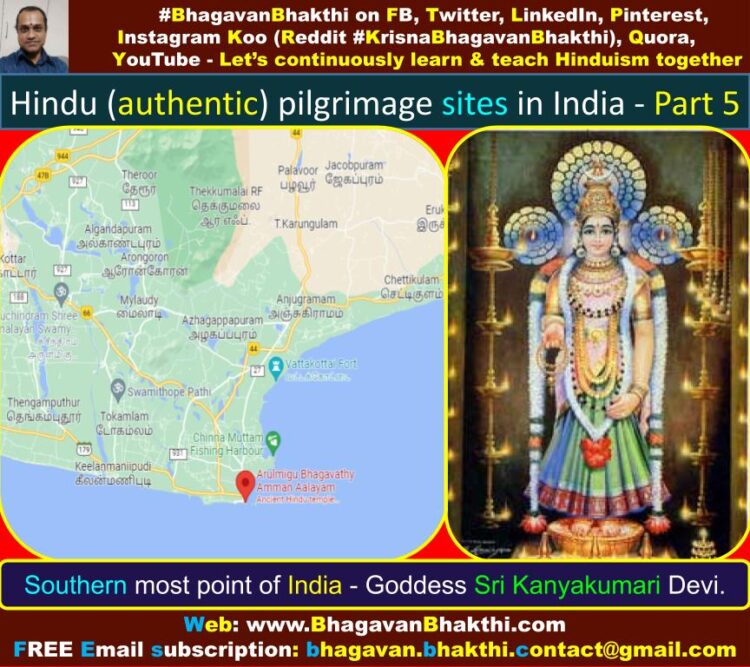
Other then ‘Kanya Tirtha‘, many other tirthas are also present in Kanyakumari as given below:
Savitri Tirtha,
Gayatri Tirtha,
Saraswati Tirtha and
Papanashini Tirtha.
In order to kill a demon called ‘Banasura’, Goddess Sri Durga Devi (Sri Maha Lakshmi Devi) took avatar as a ‘Kanya‘.
This is because, since Banasura had got a boon that he cannot be killed by anyone other than a ‘Kannika‘.
This revered place is mentioned in the Mahabharata several times. It also finds mention in several Puranas too.
Guru Sri Vadiraja Tirthat says that, Goddess Sri Mahalakshmi Devi (Sri Satyabhama Devi) destroyed an asura named ‘Banasura’ at this place.
It is also said that the arrow which Lord Krishna released to kill another asura named Banasura eventually landed at this place.
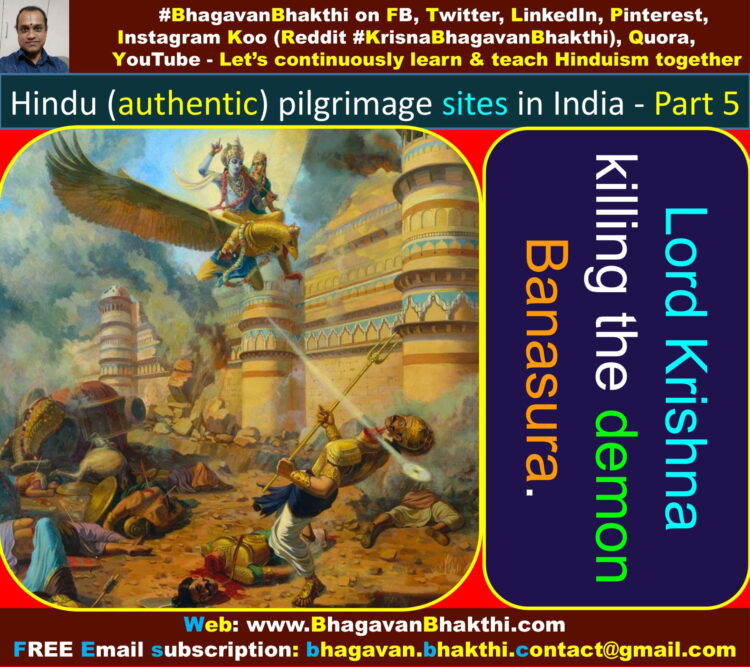
Hence Guru Sri Vadiraja Tirtha states that Goddess Sri Maha Lakshmi Devi killed an asura by the same name ‘Banasura’.
This is because to show how she (Goddess Sri Maha Lakshmi Devi) performs her dharma in accordance with what her husband Lord Vishnu.
Kanyakumari is Goddess Lakshmi or Goddess Parvati? Let’s know that from this below shloka:
Some important points to be noted down as per Guru Sri Vadiraja Tirtha is as given below:
असि मन्मथमाता त्वं कन्ये मान्यतमे सताम् | न् चेत् सौन्दर्यमाश्चर्यं कथमेतत् तनौ तव ||
Meaning of the above shloka: O Kanya! One who is most revered to Sajjanas (Follower of Dharma), you are indeed the ‘Mother of Kama Deva’.
Otherwise, how else can your body possess such amazing beauty?
Guru Sri Vadiraja Tirtha, through his explanation stresses the point repeatedly that –
the deity (murthy) at Kanyakumari is that of Goddess Sri Maha Lakshmi Devi and not of Goddess Sri Parvati Devi, as some would believe.
Goddess Sri Maha Lakshmi is the mother of Lord Kama Deva.
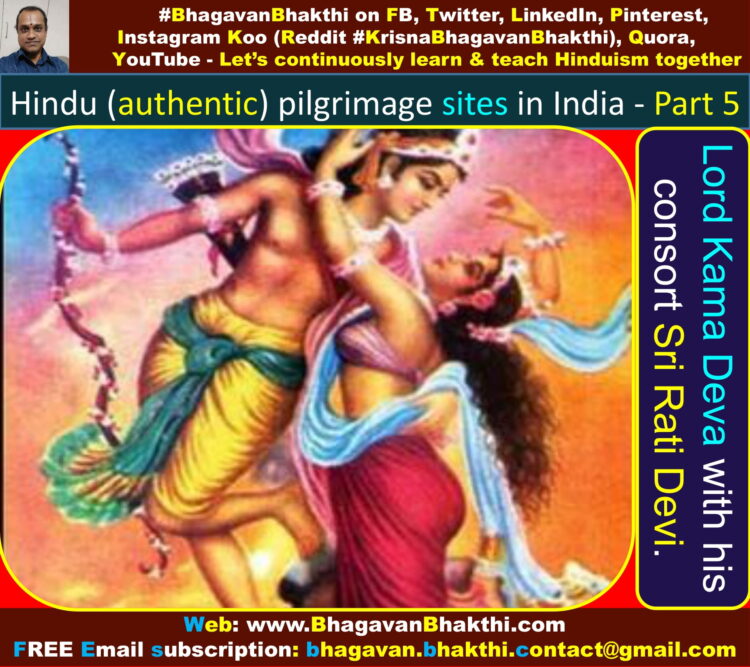
Hence it is no surprise that Goddess Sri Maha Lakshmi Devi possesses exquisite beauty in herself.
Guru Sri Vadiraja Tirtha also very clearly brings out another aspect that, Goddess Sri Maha Lakshmi (similar to Lord Vishnu) can possess opposite attributes at the same time.
E.g., Like how she is still a Kanya in spite of being the mother of Lord Kama Deva.
Agastya Varnanam (Kanyakumari) : Guru Sri Vadiraja Tirtha worships Maharishi Agastya who lived in Vyasa hills near Kanyakumari (Kanya Tirtha).
Maharishi Agastya converted the whole ocean water into a single drop and with highest ease sipped it to protect the celestials in the sea who were harassed by the demons.
Near the divine place of Kanyakumari, there is a revered hill called as ‘Vyasa Parvatam’.
Maharishi Agastya had stayed here and performed tapas (penance) as well.
Once when a number of demons with evil minds had taken shelter in the ocean.
Maharishi Agastya had gulped the entire ocean in just one sip, upon the request of Devatas (Demigods).
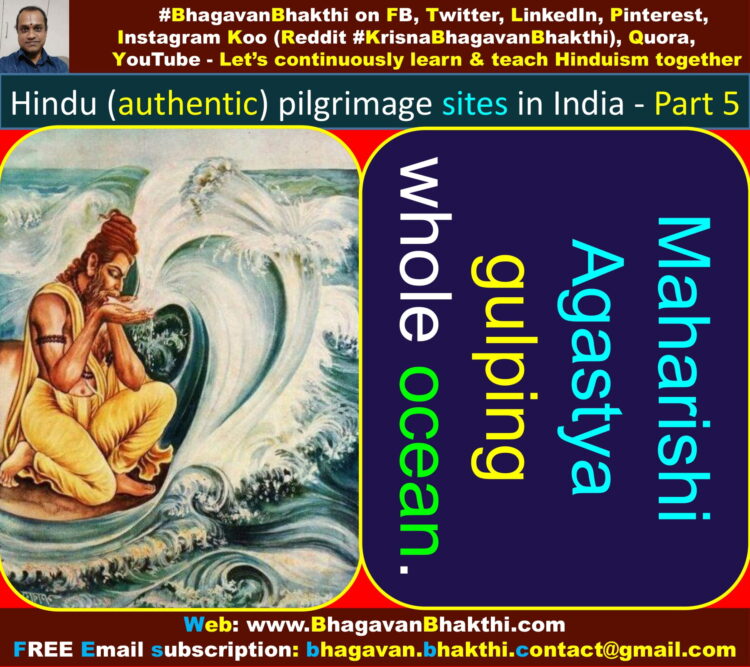
Thus, the demons who were exposed were all killed by the Devatas (Demigods).
Keeping this incident in mind, Guru Sri Vadiraja Tirtha prays to Maharishi Agastya to similarly rid us of the cycle of birth and death by consuming our ocean of Sansar (samsara) (From birth until death).
Suchindram (Suchindra Kshetra) : It is located around 13 kms away from Kanyakumari.
The King of the Devatas (Demigds) Lord Indra, who was cursed by Maharishi Gautama got deliberated at this place.
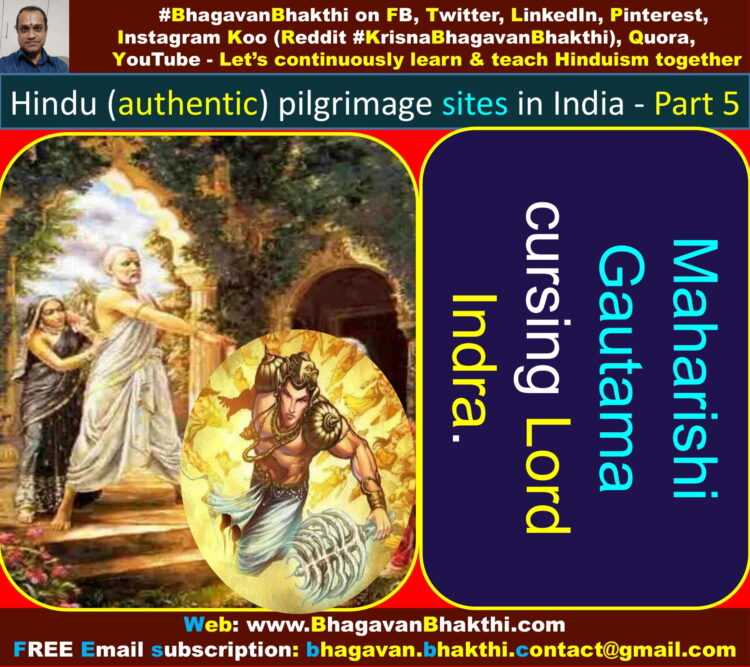
Guru Sri Vadiraja Tirtha narrates the greatness of the divine place ‘Shuchindram’ (Suchindra Kshetra).
Suchindram (Suchindra Kshetra) is a place which is about 10 kms from Kanyakumari.
It is at this place that Lord Indra had been purified after he was cursed by Maharishi Gautama.
Lord Indra had to perform a dana (donation) of his ring dipped in ghee (clarified butter) that was heated due to the rays of the sun during the afternoon of mesha masam at this place.
Since this place purified Lord Indra, it can to be known as Shuchindra (Suchindram) Suchi + Indra = Cleansed + Indra.
Guru Sri Vadiraja Tirtha says that, greater fame can be obtained by cleansing an ordinary person than someone like Lord Indra who is already a famous Devata (Demigod).
Just, doing good to the common people is that much more challenging, and greater good, than doing the same to a capable and / or qualified person.
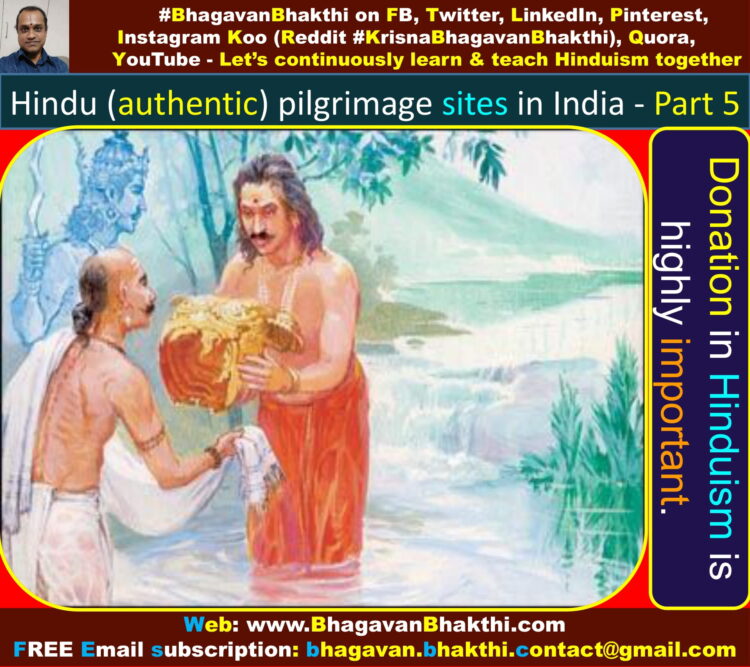
Tiruvattaru (Adi Kesava) Kshetra : This holy place is situated at Kanyakumari in Tamil Nadu and it is about 18 kms away from Trivandrum (Thiruvananthapuram – Kerala).
Guru Sri Vadiraja Tirtha explains the deity (murthy) of Lord Adi Kesava (Keshava) at Tiruvattar (Thiruvattar) (Tiruvattaru), which is about 20 kms from Thiruvananthapuram’s Lord Anantha Padmanabhaswamy in Kerala.
The deity (murthy) at Tiruvattaru (Adi Keshava) is about 22 feet long and is visible through three doors.
There is an idol of an annihilated demon near the feet of the Lord Adi Kesava (Keshava).
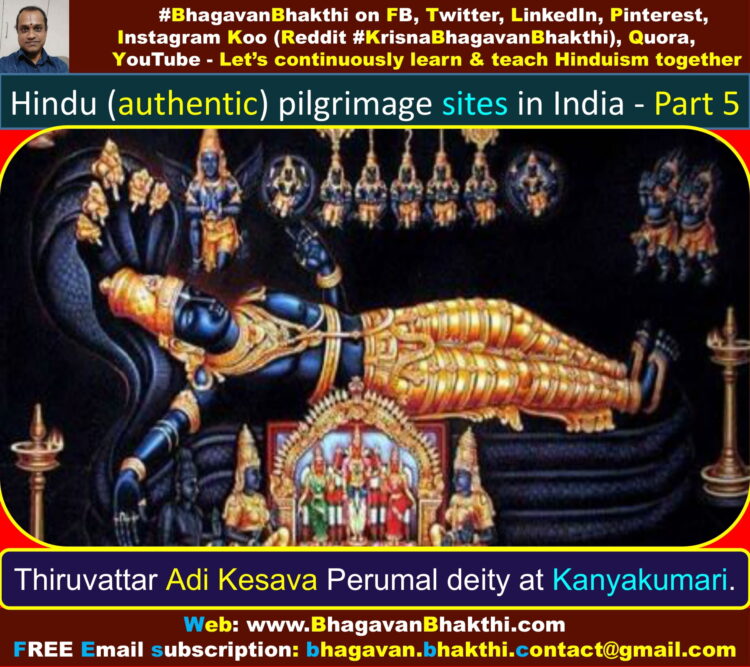
Neyyar river in Kerala (Ghritamala Kshetra) : It is located at Neyyatikara in Kerala and is 20 kms away from Thiruvattaru.
In Sanskrit ghee means Ghruta (Ghrita) and in Malayalam ghee means Neyyu (Neyyar).
The present day river Neyyar (Earlier days it was called as Ghritamala or Ghrutamala) flows near Thiruvananthapuram in Kerala.
Neyyar (Ghritamala) (Ghrutamala) river grants immense knowledge to those who take bath in it.
Hence it acts like ghrita (ghritu) (ghee) in lighting the fire of knowledge that alone can destroy our sins.
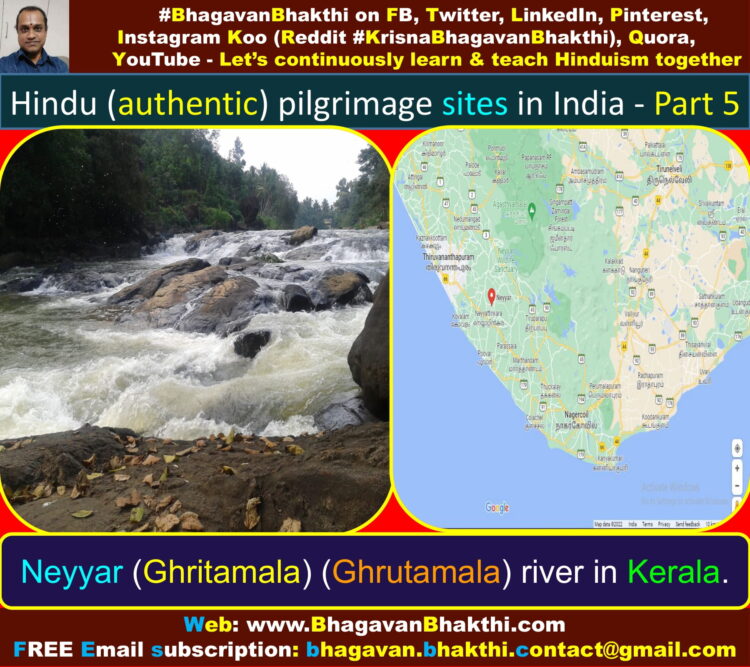
Thiruvananthapuram Sri Padmanabhaswamy temple : This temple is also called as Sri Anantha Padmanabhaswamy.
In older days, this revered temple was known as Sri Anatashayana Kshetra.
This divine temple is located around 85 kms away from Kanyakumari.
One should pray Sri Anantha Padmanabhaswamy in Thiruvananthapuram in three separate doors as the deity is too long in length.
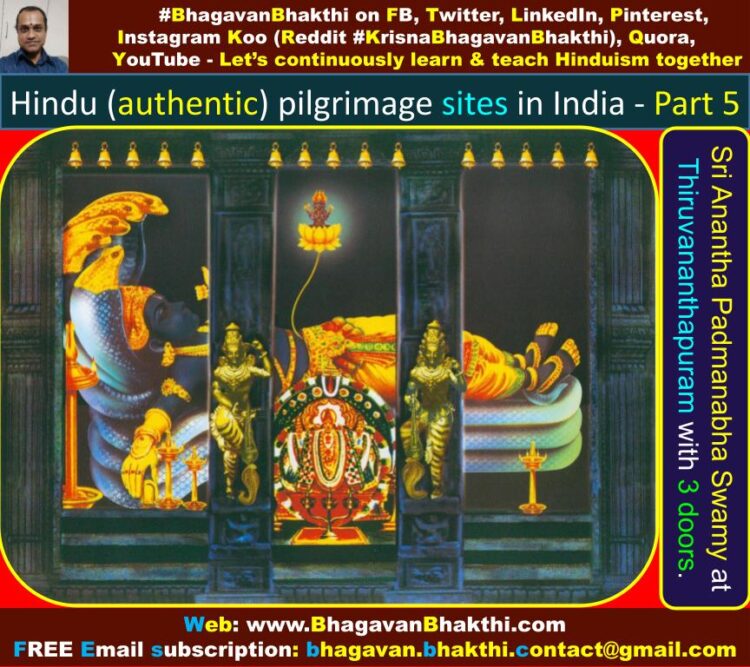
The deity (murthy) of Thiruvananthapuram, that is, Sri Padmanabhaswamy Goddess Sridevi (Lakshmi) and Goddess Bhudevi (Mother Earth) at his feet.
Also has Lord Brahma sitting on a lotus flower whose roots are in the navel of Lord Sri Padmanabhaswamy.
Lord Sri Padmanabhaswamy is resting on Lord Shesha Deva.
This temple and place is mentioned in numerous Puranas and also in the great epic of Mahabharata.
Guru Sri Vadiraja Tirtha brings out the facts that, Lord Vishnu has no need for being in the resting position at all.
Here Lord Sri Padmanabhaswamy (Lord Vishnu) is in the sleeping position, only to bless all his devotees
Lord Sri Padmanabhaswamy (Lord Vishnu) is completely free from defects, including sleep.
Guru Sri Vadiraja Tirtha also indicates that, the reason Lord Sri Padmanabhaswamy is visible through three doors at Thiruvananthapuram is because of the following reason:
To convey the message of the upanishads, that is, “atma vaare drashTavyaH shrOtavyO mantavyO nidhidhAsitavyaH” directly to the devotees.
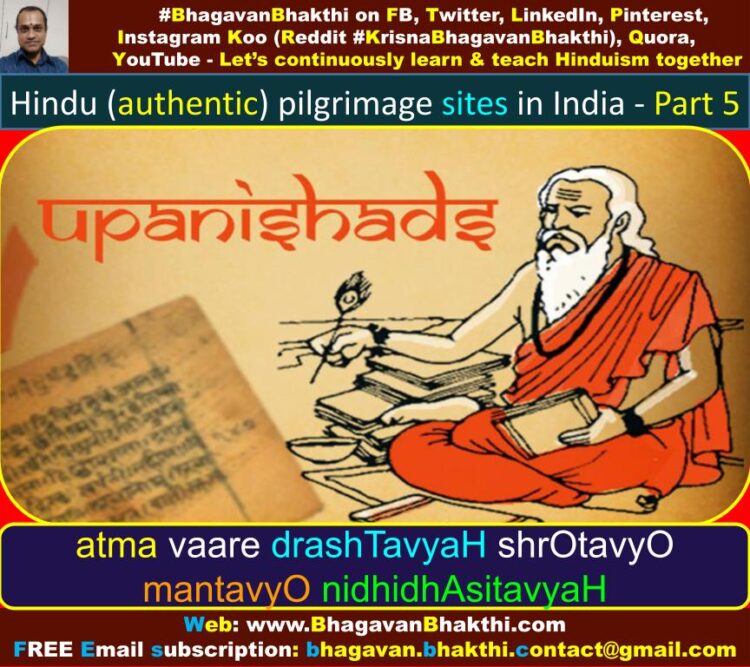
Thus his devotees can continuously and constantly engage in ‘shravana‘ (hearing), ‘manana‘ (thinking) and ‘dhyana‘ (meditating) in order to eventually realise him (Lord Vishnu).
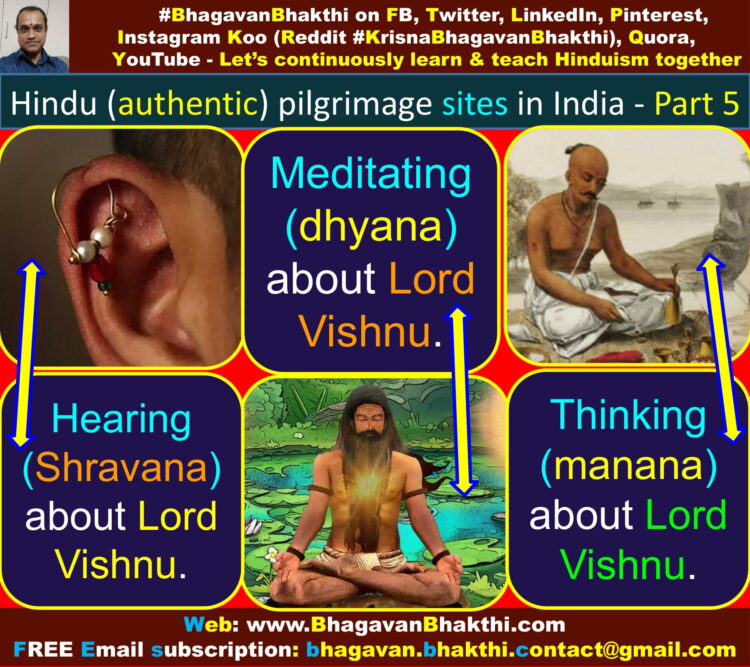
Lord Padmanabhaswamy, by showing the three parts of his body, that is, his feet, his mid region and his face, (through the three doors) respectively.
Thus he is clearing any doubts with respect to the resemblance in the ‘taittareeya upanishad‘.
This ‘taittareeya upanishad‘ states that the result for worshipping the three regions of Lord Vishnu’s body is the darshana of those very parts of his body in moksha (Divine liberation) (A place in Vaikuntha).
We should always remember that, Lord Vishnu is the main and only controller of anything and everything in these unlimited Universes.
And he does it with highest east and without any effort, although he appears to be sleeping always.
That is a proof of his infinite ability, power, strength, etc.
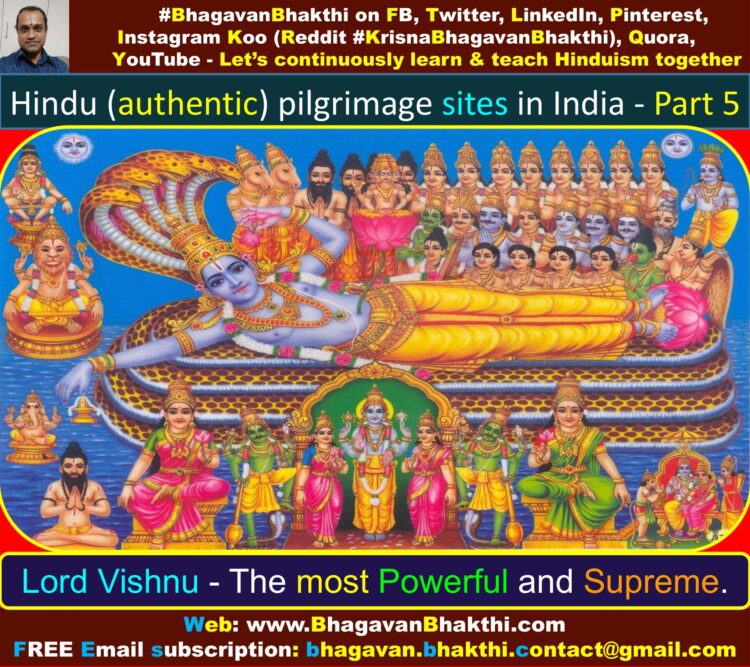
Hindu Puranas says that, the ‘Sri Anantha Padmanabhaswamy‘ deity at Thiruvananthapuram is at the entrance of a cave.
Guru Sri Vadiraja Tirtha uses this fact to pray to Lord Vishnu to also reside in the hearts of the devotees.
With this, Guru Sri Vadiraja Tirtha offers the entire grantha (text) “Tirtha Prabandha” at the holy feet of Sri Ananta Padmanabhaswamy.
Finally Guru Sri Vadiraja Tirtha submitted this holy Grantha “Tirtha Prabhanda” in this place of Thiruvananthapuram to Lord Sri Ananta Padmanabhaswamy.
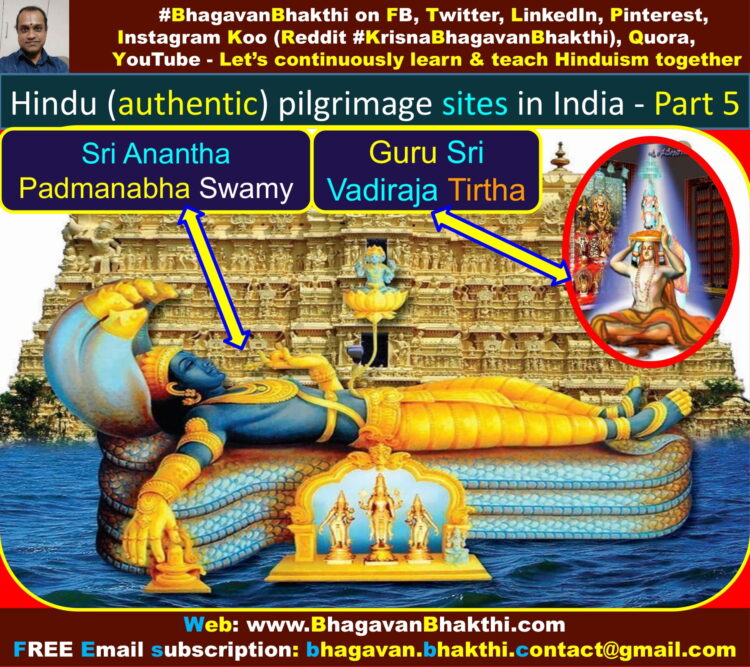
To watch videos on #Hinduism #Sanskrit language, SUBSCRIBE to my YouTube channel from this below link:
#BhagavanBhakthi YouTube channel
For “Hindu (authentic) pilgrimage sites in India – Part 1“, please click the below link:
Hindu (authentic) pilgrimage sites in India – Part 1
For “Hindu (authentic) pilgrimage sites in India – Part 2“, please click the below link:
Hindu (authentic) pilgrimage sites in India – Part 2
For “Hindu (authentic) pilgrimage sites in India – Part 3“, please click the below link:
Hindu (authentic) pilgrimage sites in India – Part 3
For “Hindu (authentic) pilgrimage sites in India – Part 4“, please click the below link:
Hindu (authentic) pilgrimage sites in India – Part 4
To know about “Ekadashi unknown facts” and real significances of Ekadashi fasting, kindly click the below link:
To know more about “Lord Krishna unknown facts“, please click the below link:
To know more about “Lord Vishnu unknown facts“, please click the below link:
To know more about “Lord Shiva unknown facts“, please click the below link:
Dear friends, if you need any clarifications about this post, kindly let me know, I will definitely try to answer all of them.
Also your one LIKE, one COMMENT, One Share, one SUBSCRIPTION is highly important.
This will help to know the quality of this content and also it will be helpful to know if any improvements is required for the content.
If you feel this content is useful to you and has helped you to improve your knowledge, kindly share this with your well-wishers.
Because “SHARING MEANS CARING”.
For receive FREE EMAIL SUBSCRIPTION about #BhagavanBhakthi, you can send an email to [email protected] from your email ID.
NAMASTE!
Sri Gurubhyo Namaha
OM NAMO NARAYANAYA
Sri Krishnaarpanamastu
Subscribe / Follow us Share in Social Media
I was very happy to discover this website. I want to to thank you for your time due to this fantastic read!! I definitely liked every little bit of it and i also have you book marked to check out new things on your blog.
I truly appreciate this post. I’ve been looking all over for this! Thank goodness I found it on Bing. You have made my day! Thanks again!